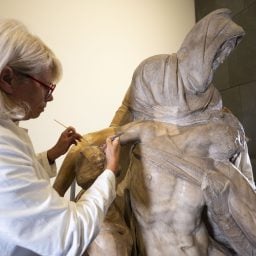For the first time, a cache of rare Michelangelo drawings, nearly all of them double-sided, from the collection of Queen Christina of Sweden, is headed to the US.
Stretching across 25 individual sheets, the delicate artworks include preparatory drawings for the Sistine Chapel ceiling and for statues commissioned by Pope Leo X for the Medici tombs in Florence’s San Lorenzo Church. The trove touched down at the Cleveland Museum of Art this past weekend; in February, they head to the J. Paul Getty Museum in Los Angeles.
“It’s going to show you the whole arc of Michelangelo’s career,” Heather Lemonedes, the Cleveland Museum’s deputy director and chief curator, told artnet News. “The exhibition will really show all the different ways that Michelangelo was working, and his different types of projects.”
The show includes early drawings for Michelangelo’s unrealized fresco Battle of Cascina, which would have graced Florence’s Palazzo Vecchio; architectural studies for the dome of St. Peter’s in Rome, which he worked on from 1547 until his death in 1564; and figurative studies made throughout his career.
“From the 1490s onward, Michelangelo was drawing from corpses and flayed human bodies so he could have a better understanding of human anatomy,” Lemonedes said.
Co-organized by the Cleveland and Los Angeles museums, the show came together thanks to a rare loan from the Teylers Museum in Haarlem, the Netherlands, currently closed for renovations. The Teylers Foundation purchased the works, a fraction of the 2,000-piece art collection amassed by Queen Christina, in 1790. Since that time, the drawings have never left the museum—and not because no one ever asked.
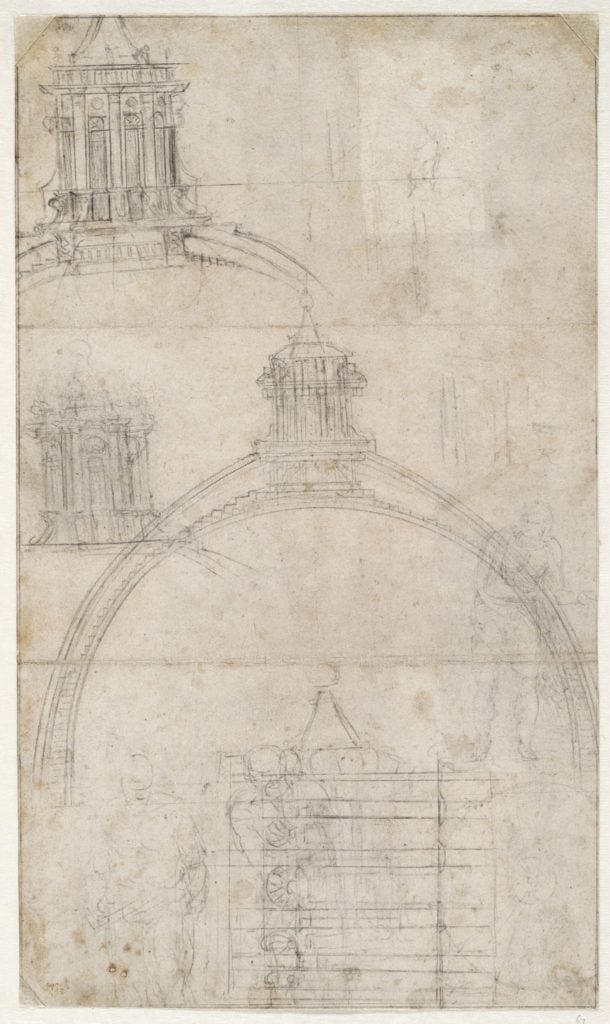
Michelangelo, Section through the dome of Saint Peter’s with alternative designs for the lantern; figure sketches (circa 1547–59). Courtesy of the Teylers Museum, Haarlem.
The Metropolitan Museum of Art originally wanted to include the Teylers works in their blockbuster show, “Michelangelo: Divine Draftsman and Designer.” The ambitious exhibition included loans of Michelangelo drawings from 50 public and private collections in the US and Europe, including the Louvre in Paris and the Vatican Library, but the Teylers Museum nonetheless refused to lend their collection.
“The Met really wanted them,” Lemonedes said. “But the Teylers Museum didn’t want their Michelangelo collection to get lost in the shuffle of the big Met show.”
By any yardstick, the show was a huge success for the Met, bringing in 700,000 visitors and helping set an annual attendance record for the institution. But for Michelangelo completists left wanting more, it may be time to make a pilgrimage to Cleveland or to the Getty.
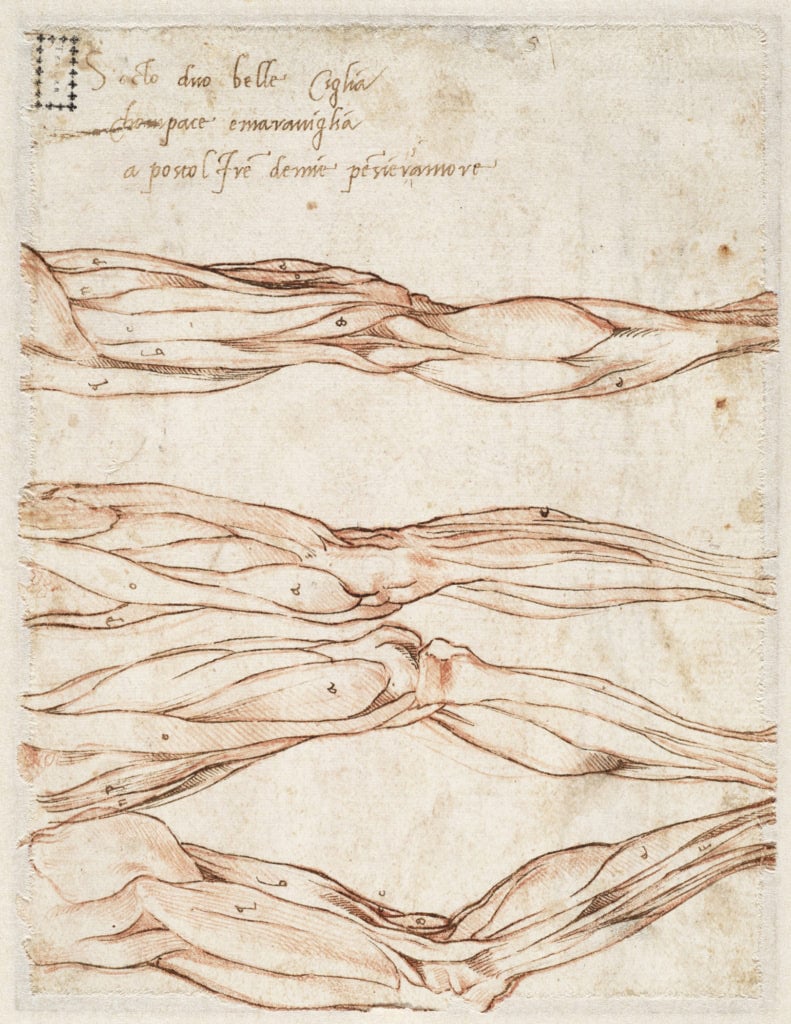
Michelangelo, Four studies of a leg (circa 1515–20), verso. Courtesy of the Teylers Museum, Haarlem.
The exhibition, titled “Mind of the Master,” will be rounded out by two works by the artist from the Getty’s own holdings, and one from the Cleveland Museum, for 28 Michelangelo sheets in total.
“Being able to show all of these drawings at one time is really a coup,” Lemonedes said. “At the Teylers they’re in storage because they’re light sensitive, so it’s not like you can even go to the Netherlands and see all of them.”
And though Michelangelo is estimated to have created as many as 20,000 drawings over the course of his long career, only about 600 are known to have survived.

Michelangelo, Head of a child with a cloth around its head (circa 1520s), recto. Courtesy of the Teylers Museum, Haarlem.
“Michelangelo valued his drawings tremendously, but he was also quite private about them,” Lemonedes explained. “He didn’t want people stealing his ideas, and he didn’t necessarily want people to know that he labored over the creative process. He wanted to it to appear as if these sculptures and frescos just popped out of his being fully formed, without any blood, sweat, and tears.”
The exhibition also offers select glimpses of the artist’s personality. “Michelangelo was a poet as well as a sculptor, a painter, an architect, and he would write poetry on his drawings and send them to friends,” Lemonedes said. “It shows how intimate the drawings are. They are in some ways like a diary or a journal; they show his thoughts, his creative process.”
See more works from the exhibition below.
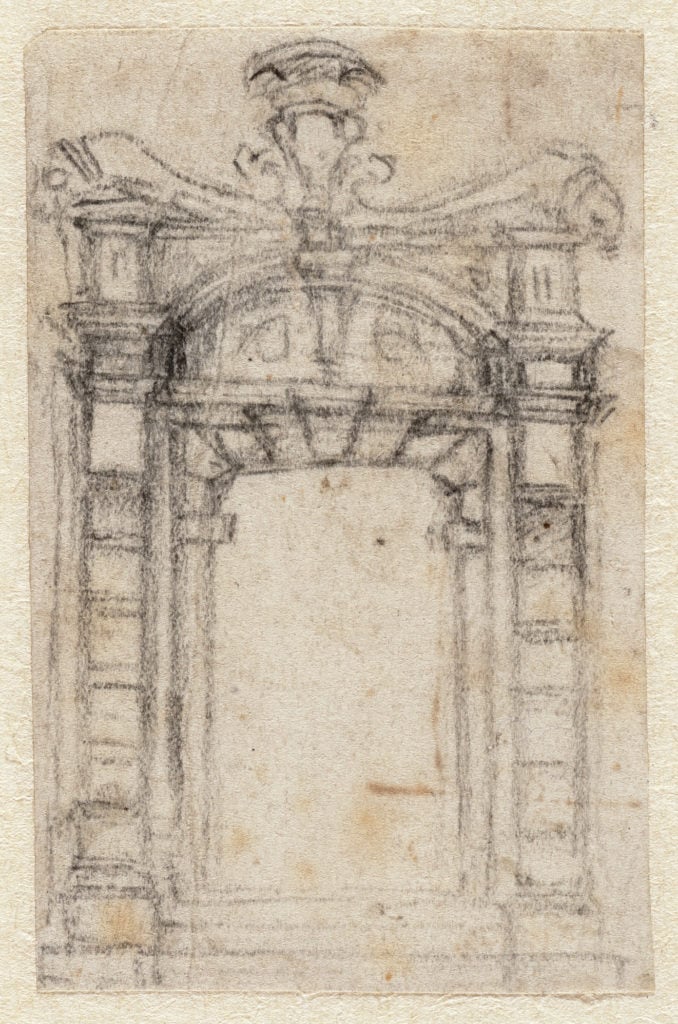
Michelangelo, Study for a portal (1560–64), recto. Courtesy of the Teylers Museum, Haarlem.
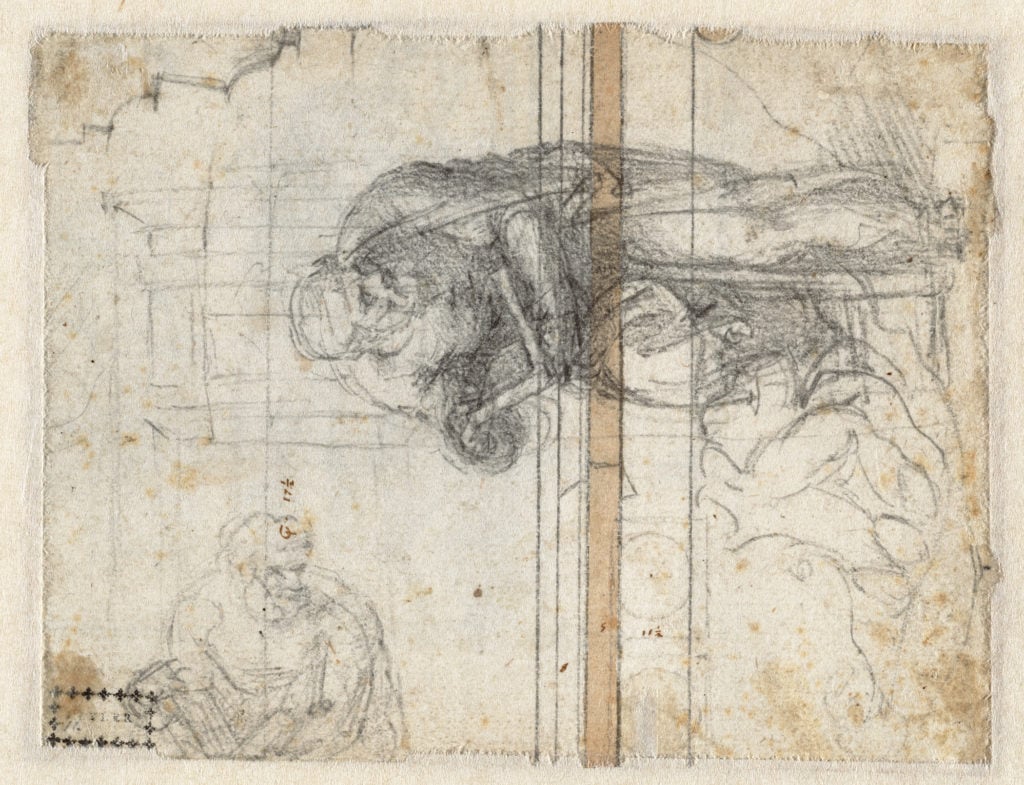
Michelangelo, Studies of a prophet or evangelist; architectural studies; sketch of a male torso (circa 1555–58), verso. Courtesy of the Teylers Museum, Haarlem.
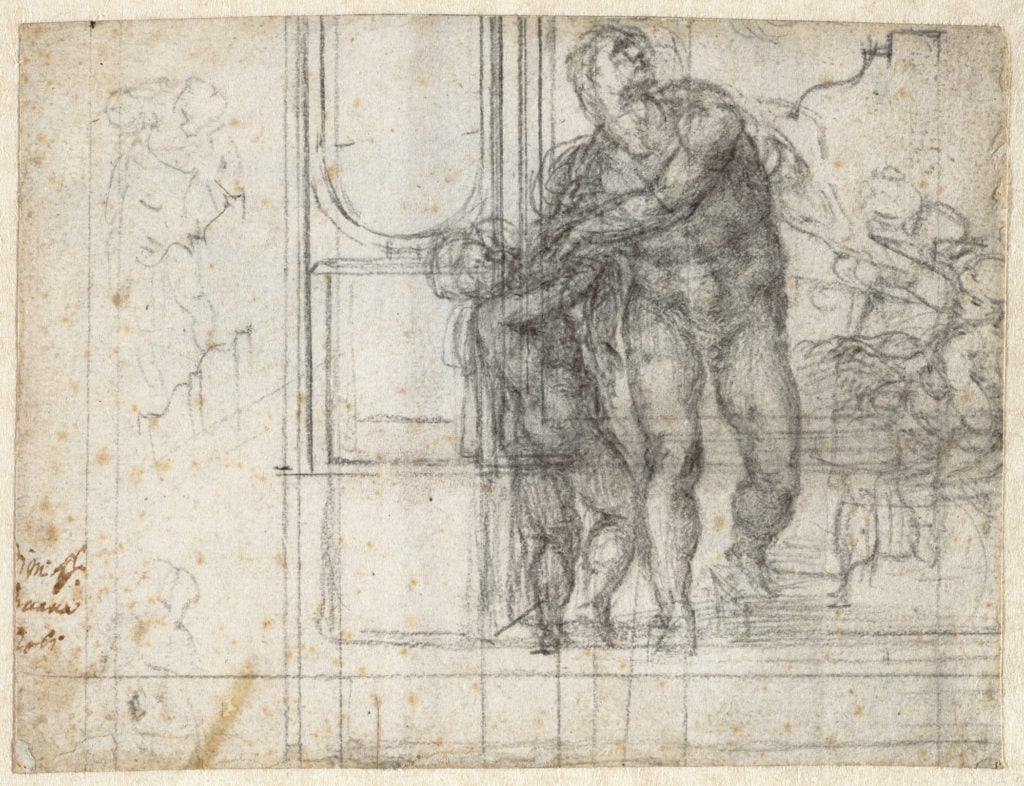
Michelangelo, Aeneas with Ascanius, summoned to leave Dido; architectural studies (circa 1555), recto. Courtesy of the Teylers Museum, Haarlem.
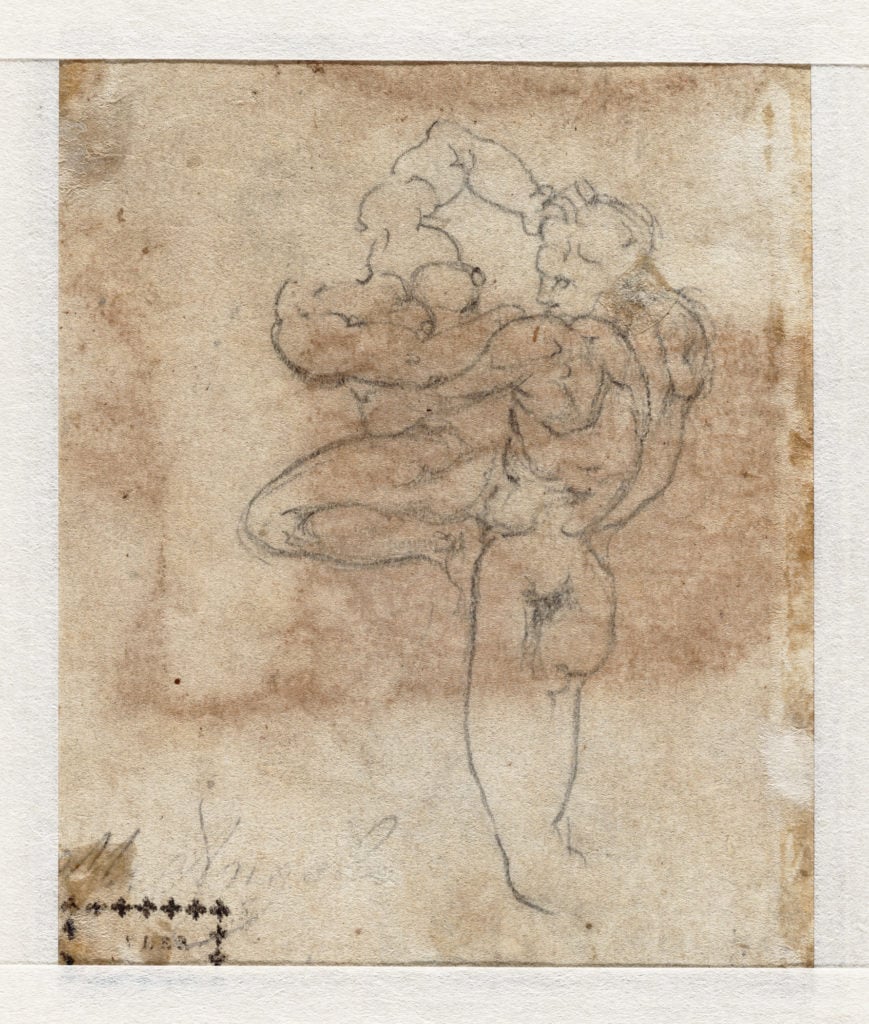
Michelangelo, A man abducting a woman (tracing), (1530–34), verso. Courtesy of the Teylers Museum, Haarlem.
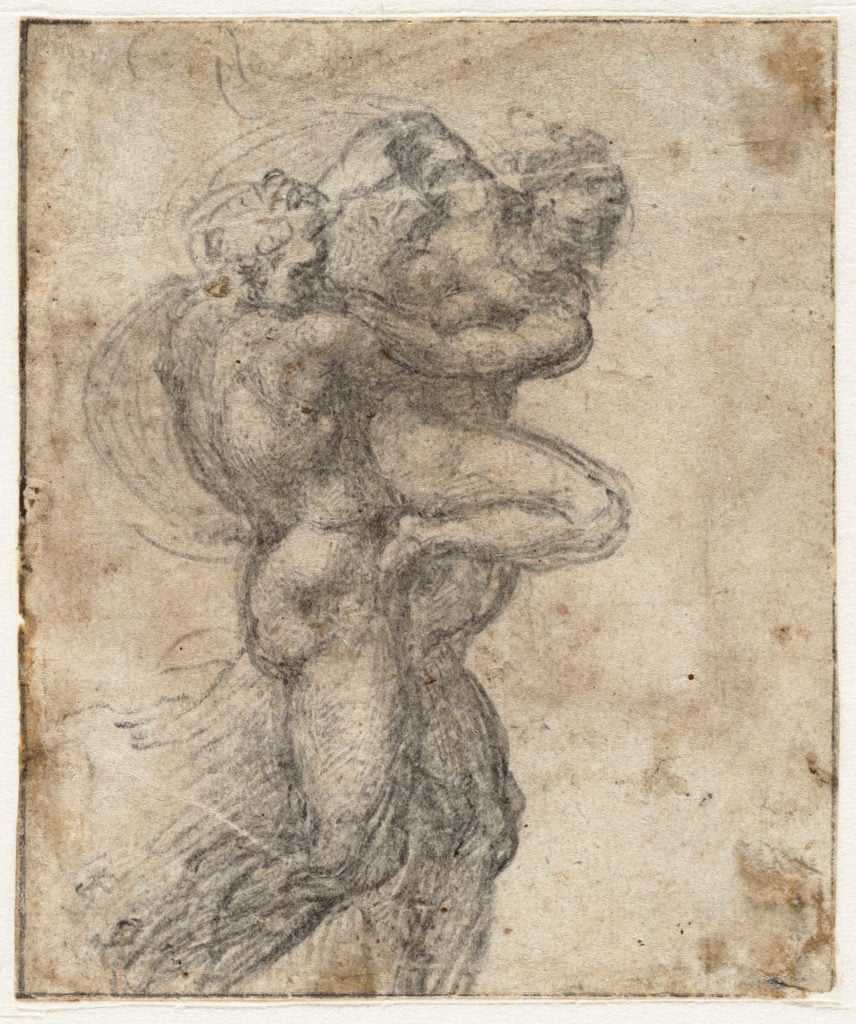
Michelangelo, A man abducting a woman (1530–34), recto. Courtesy of the Teylers Museum, Haarlem.
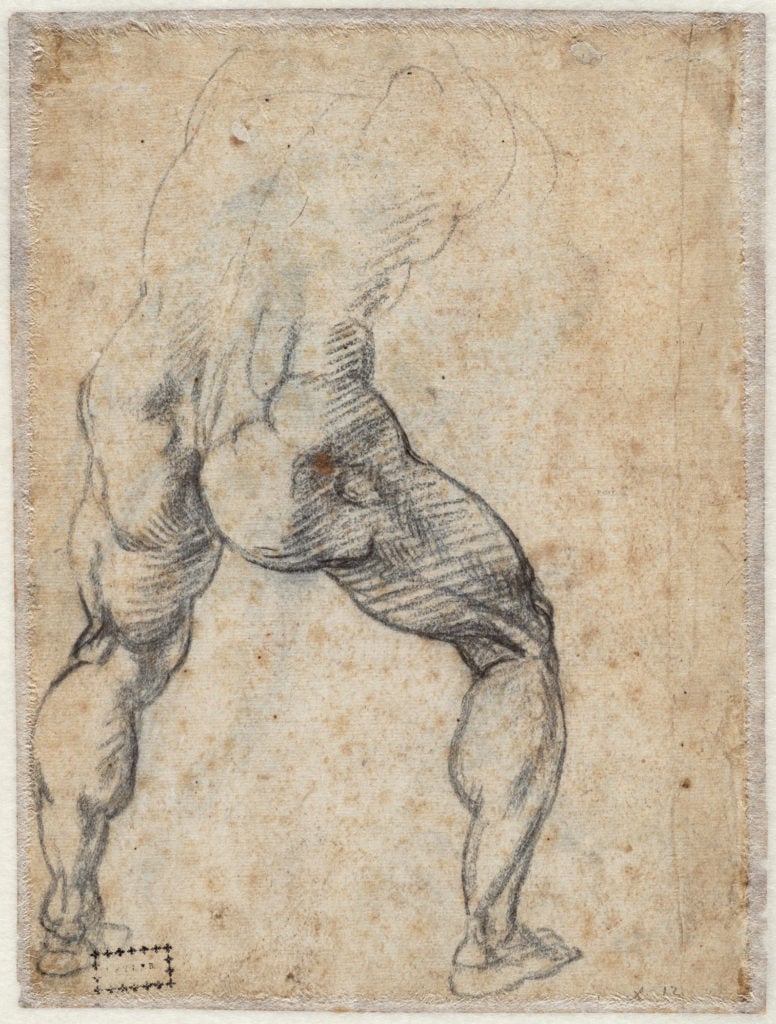
Michelangelo, Study of a male nude; separate study of his head (circa 1537), recto. Courtesy of the Teylers Museum, Haarlem.
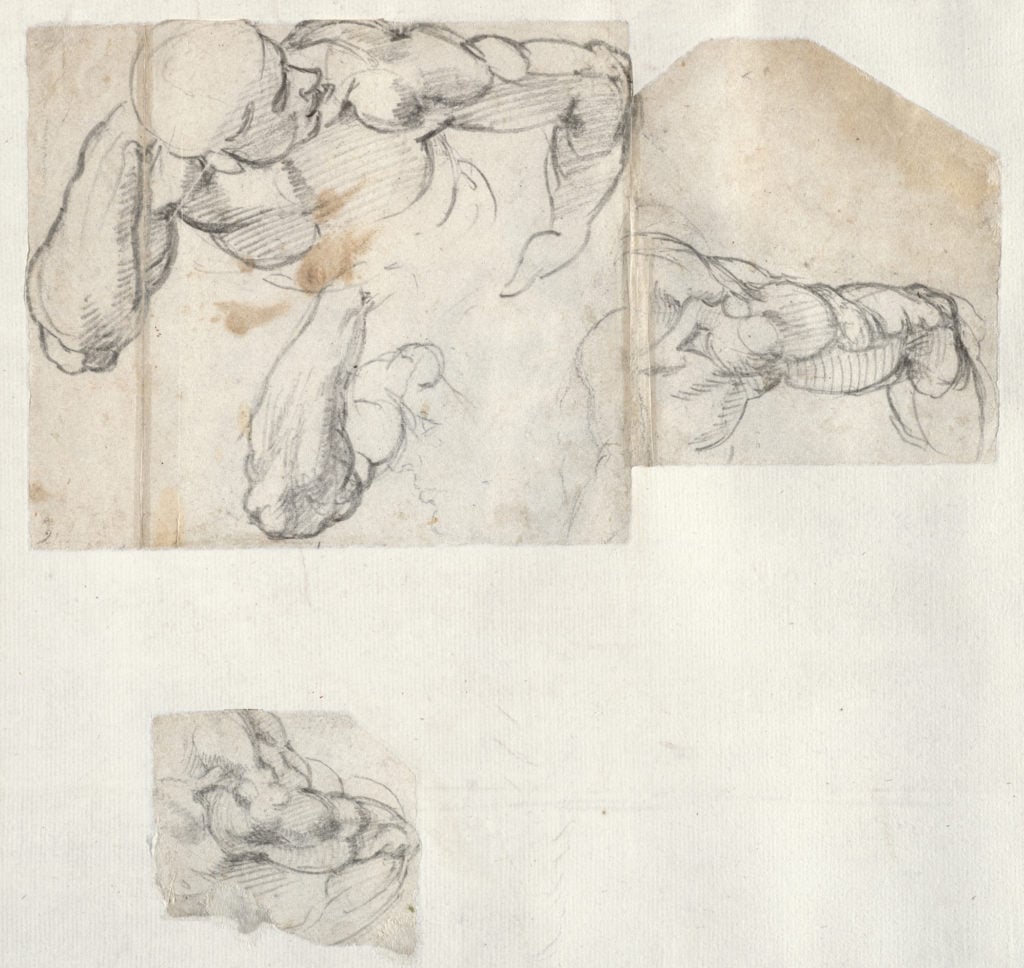
Michelangelo, Male nude (circa 1537), verso. Courtesy of the Teylers Museum, Haarlem.
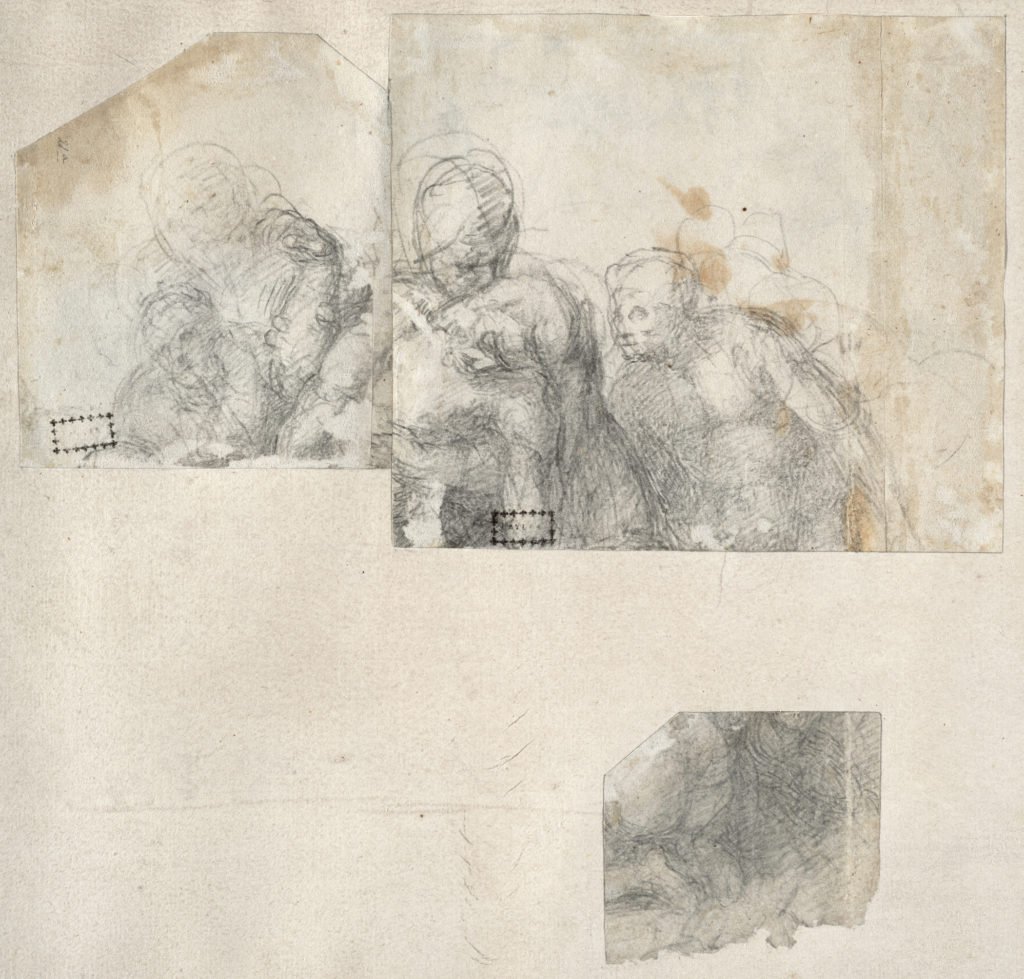
Michelangelo, Pietà (fragmentary) (circa 1550–55) verso. Courtesy of the Teylers Museum, Haarlem.
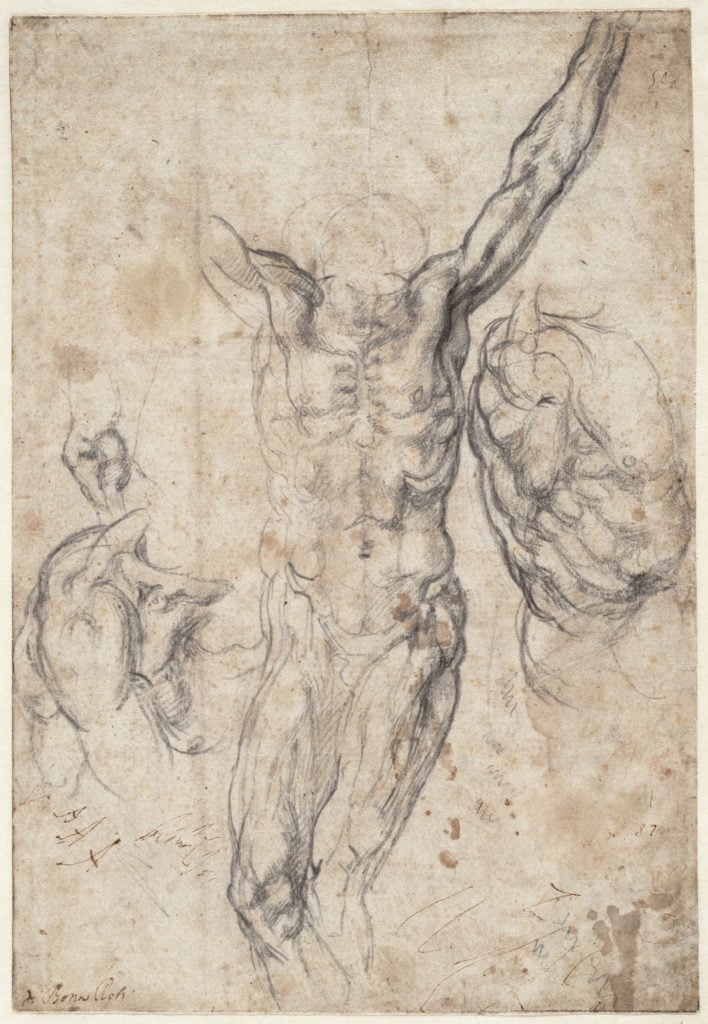
Michelangelo, Four studies, including two for a crucified figure (1530–34), recto. Courtesy of the Teylers Museum, Haarlem.
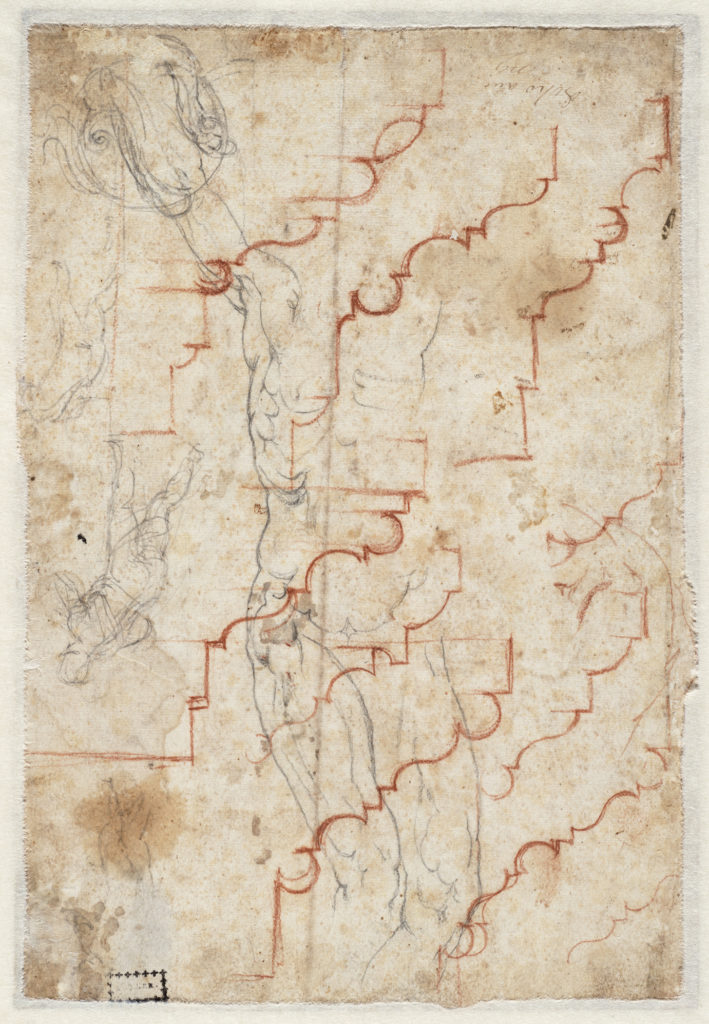
Michelangelo, Crucified figure (tracing); architectural profiles; figure sketches (1530–34), verso. Courtesy of the Teylers Museum, Haarlem.
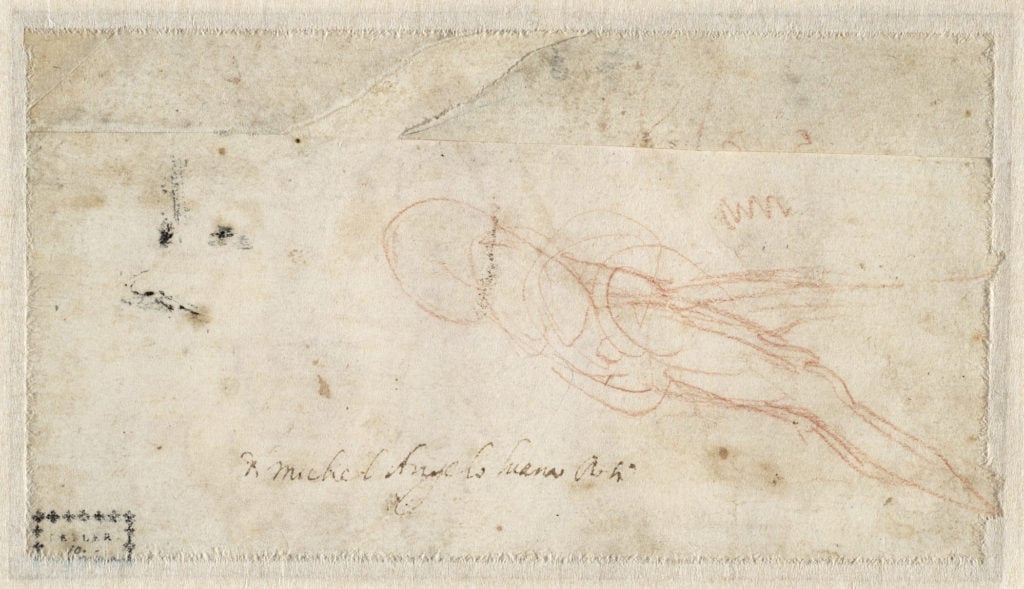
Michelangelo, Sketch of headless figure, striding to the right (circa 1517), verso. Courtesy of the Teylers Museum, Haarlem.
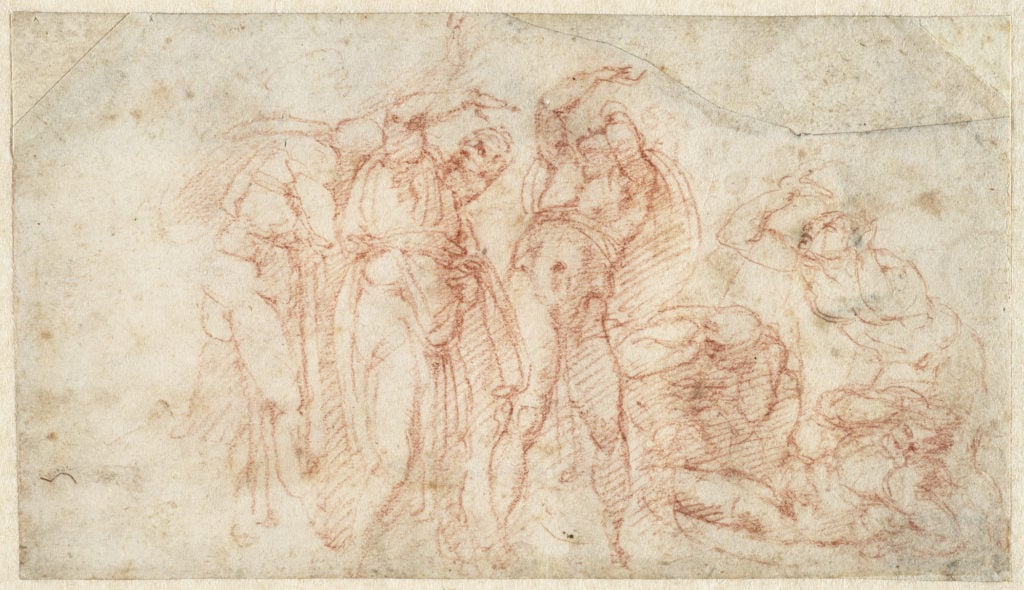
Michelangelo, Six figures in attitudes of fear and terror (circa 1517), recto. Courtesy of the Teylers Museum, Haarlem.
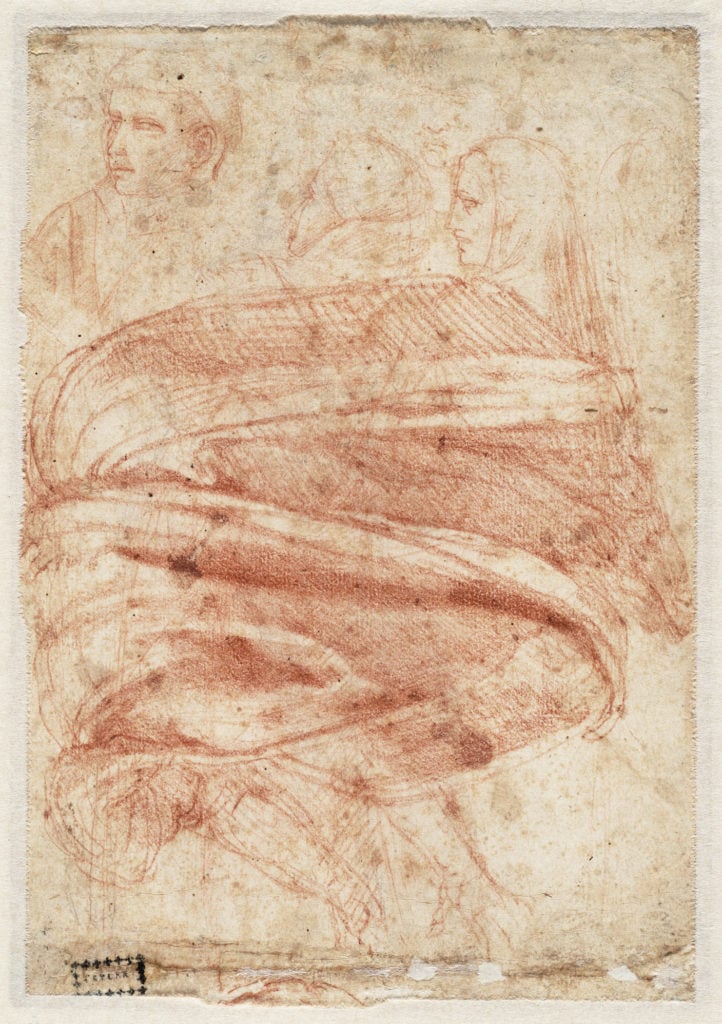
Michelangelo, Woman bending forward; five heads (after Giotto), circa 1530–34, recto. Courtesy of the Teylers Museum, Haarlem.
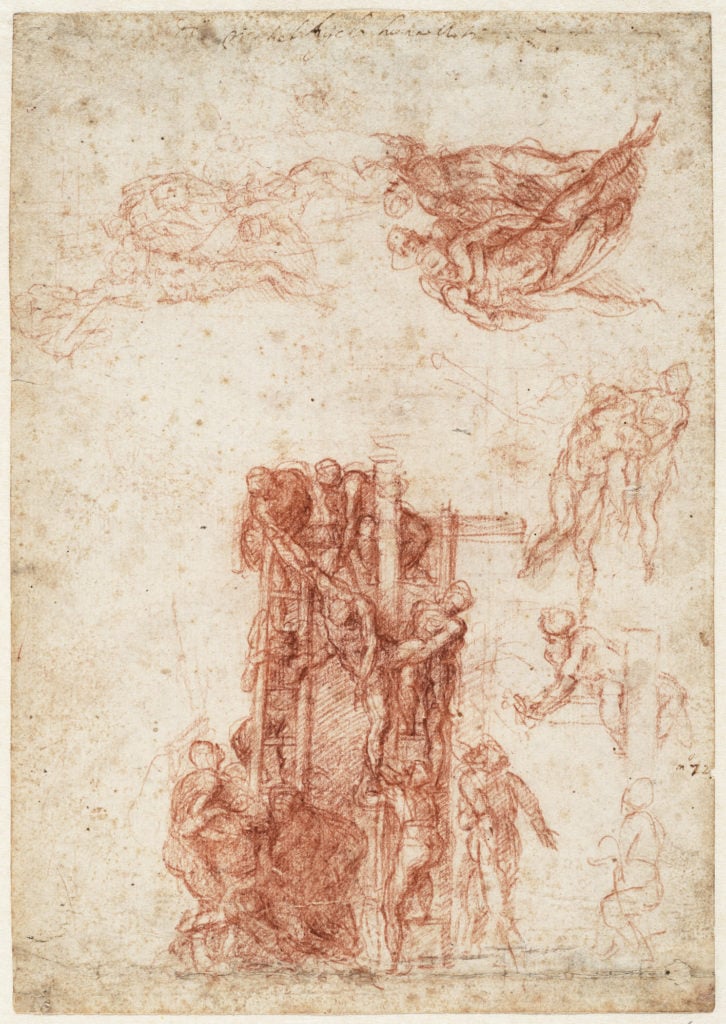
Michelangelo, Studies for a deposition from the cross (circa 1530–34), recto. Courtesy of the Teylers Museum, Haarlem.
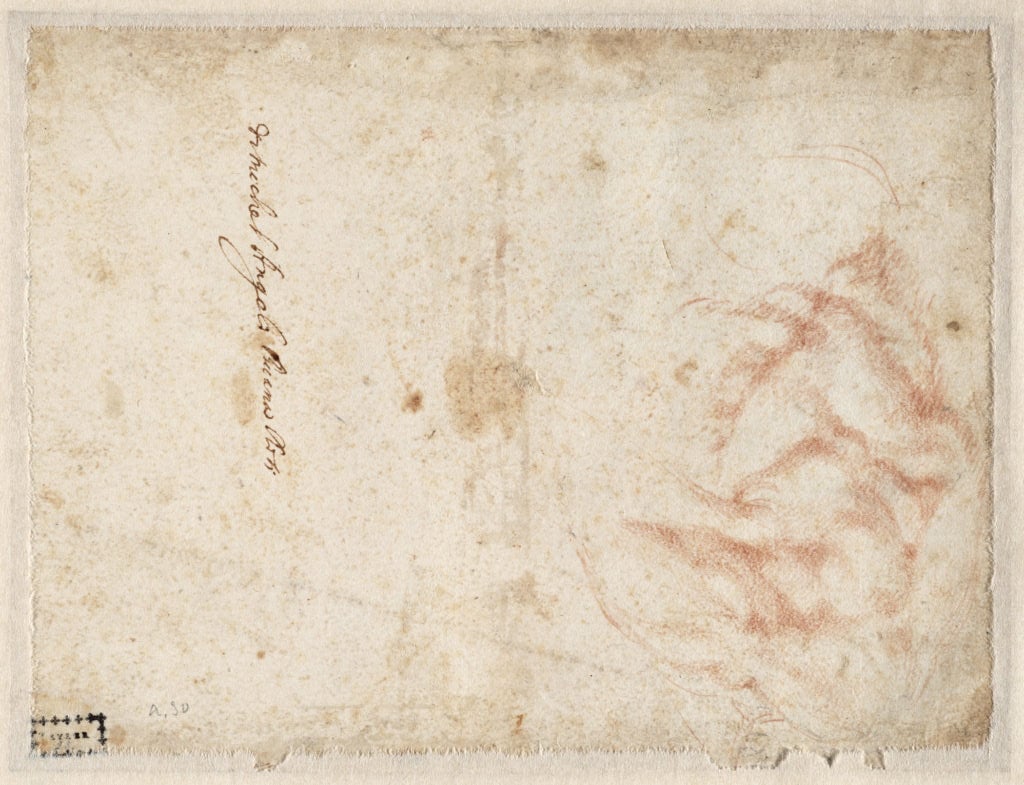
Michelangelo, Study of the right shoulder (1523–24), verso. Courtesy of the Teylers Museum, Haarlem.
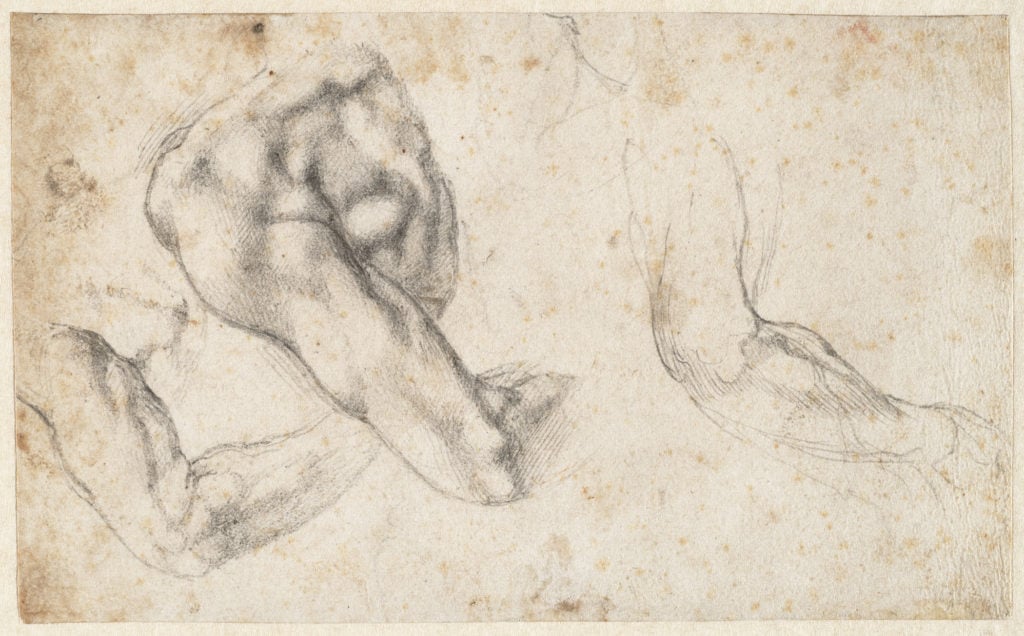
Michelangelo, Three studies of a left arm and shoulder, seen from the back (1523–24), recto. Courtesy of the Teylers Museum, Haarlem.
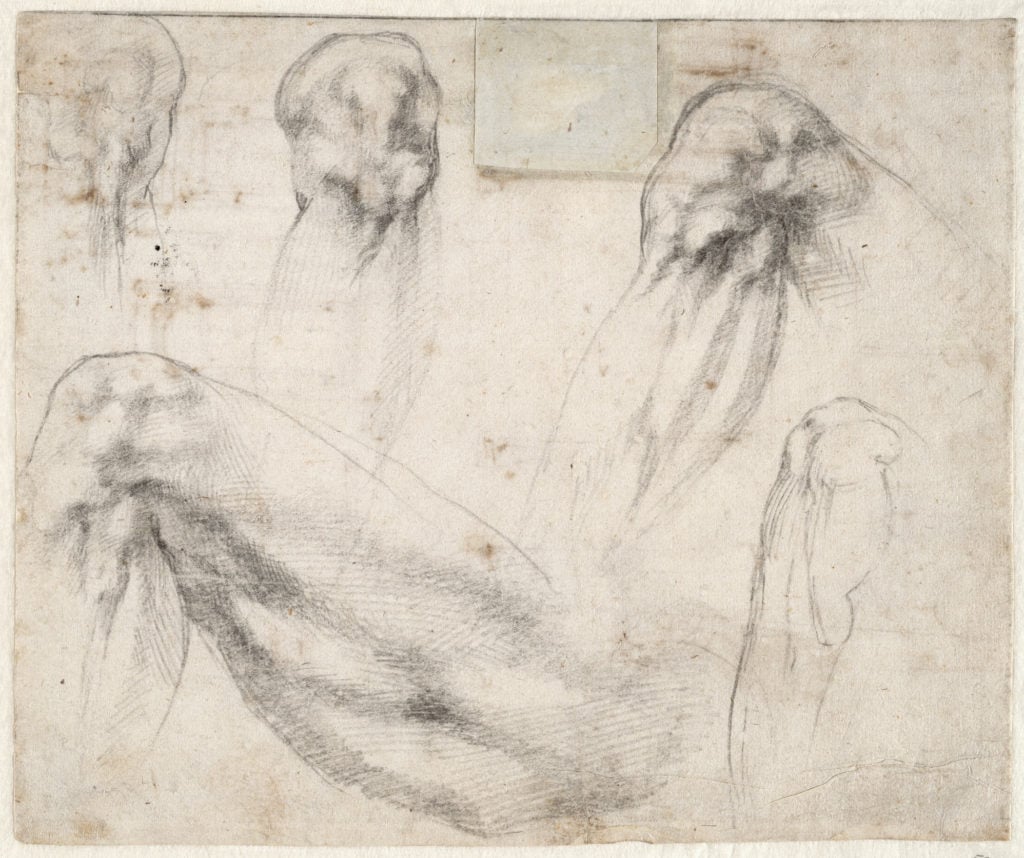
Michelangelo, Studies of a left leg and four studies of a knee (1523–24), recto. Courtesy of the Teylers Museum, Haarlem.
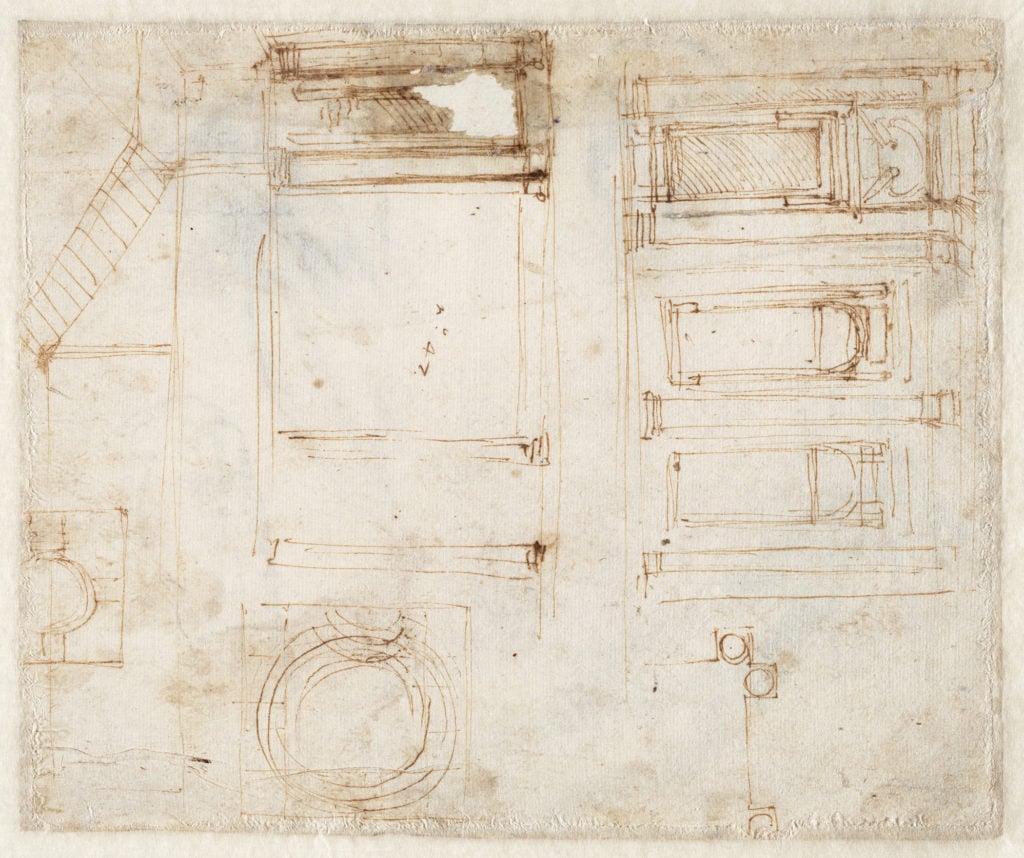
Michelangelo, Architectural studies (1524), verso. Courtesy of the Teylers Museum, Haarlem.
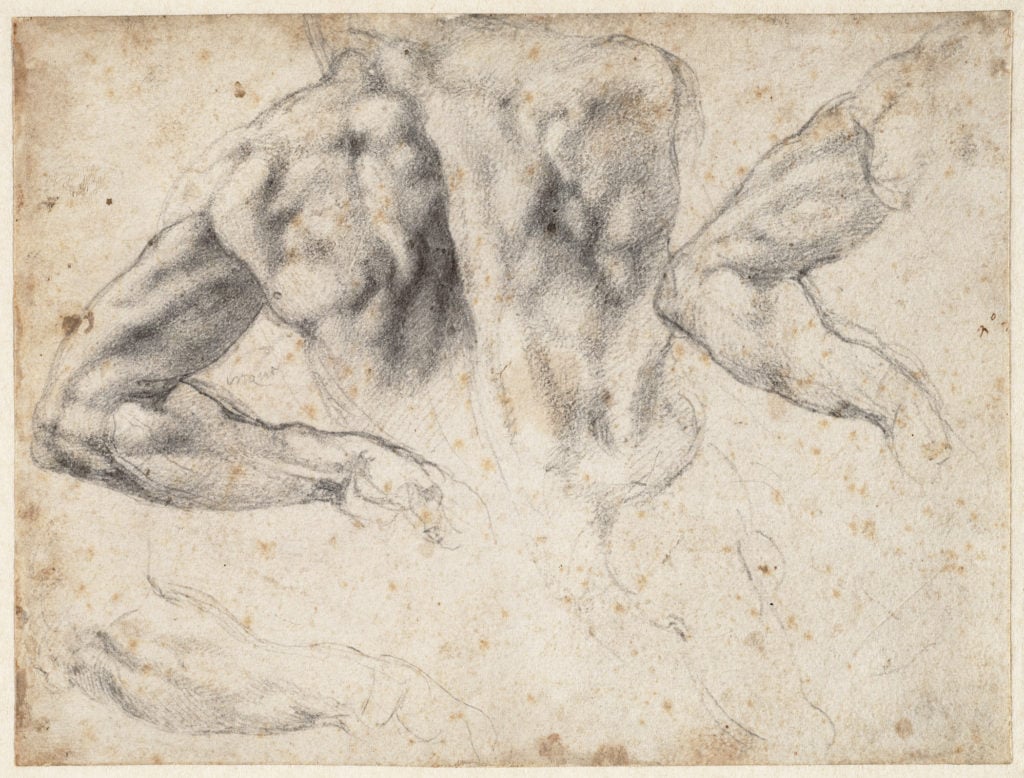
Michelangelo, Study of the back and left arm of a male nude (1523–24), recto. Courtesy of the Teylers Museum, Haarlem.
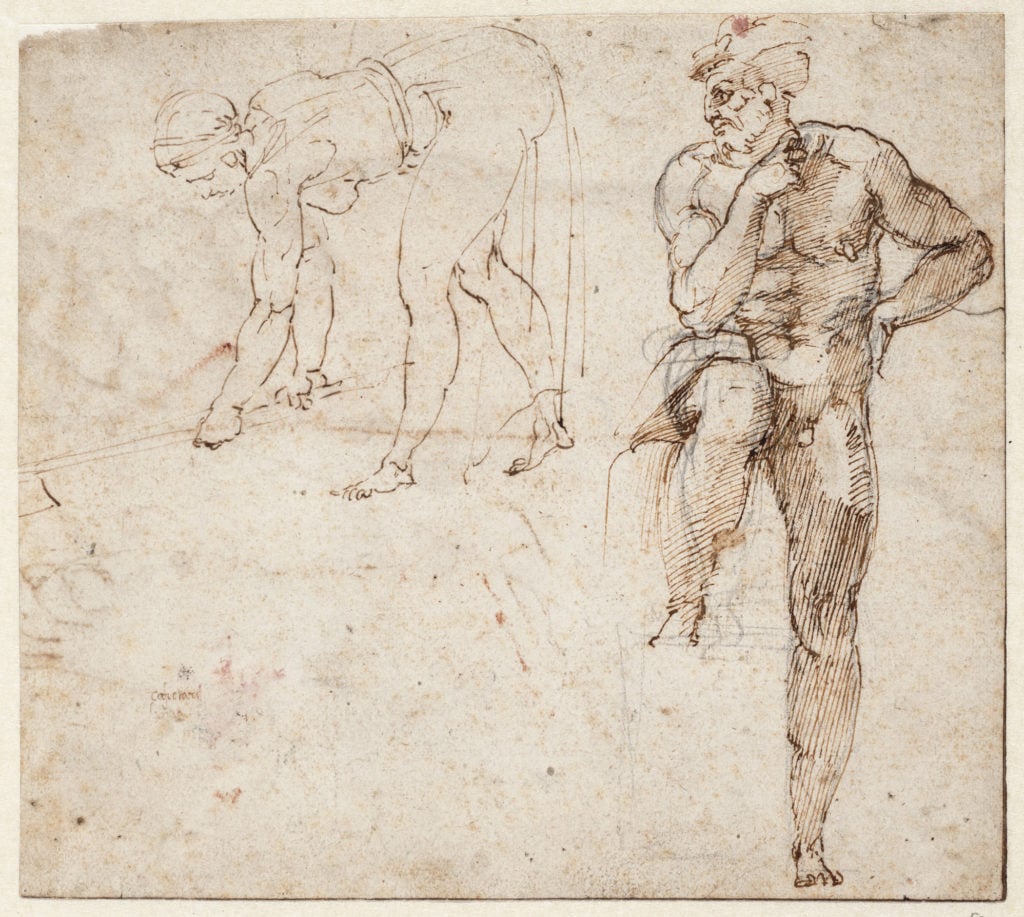
Michelangelo, Standing man, a woman hoeing (1517–23), recto. Courtesy of the Teylers Museum, Haarlem.
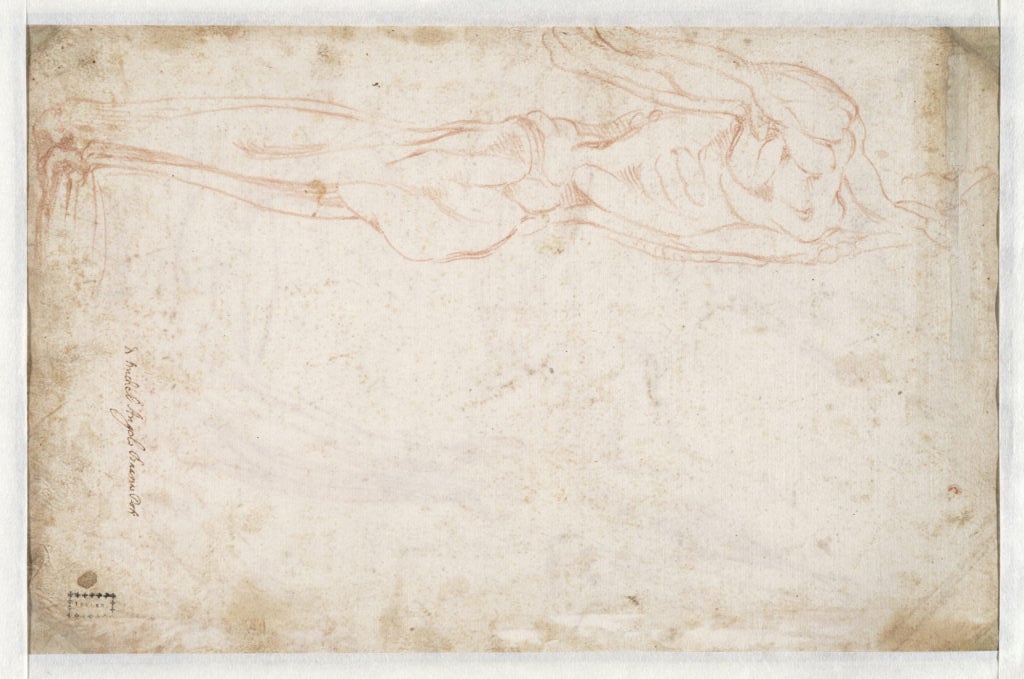
Michelangelo, Studies of a kneeling male figure, from the left (1515–20), verso. Courtesy of the Teylers Museum, Haarlem.
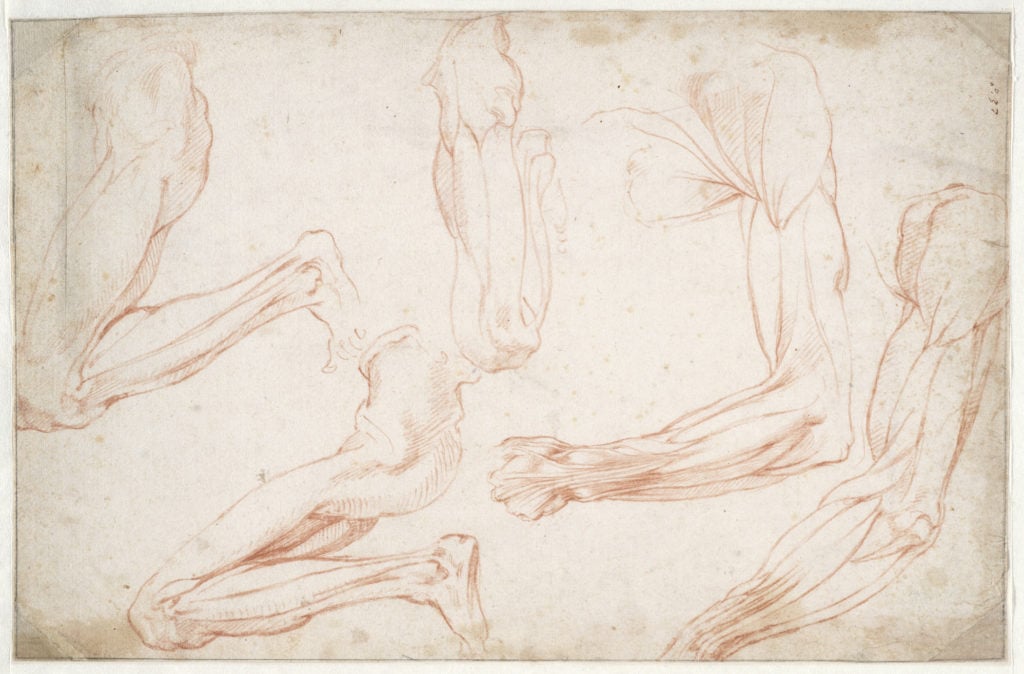
Michelangelo, Studies of a bent left leg and a bent left arm (1515–20), recto. Courtesy of the Teylers Museum, Haarlem.
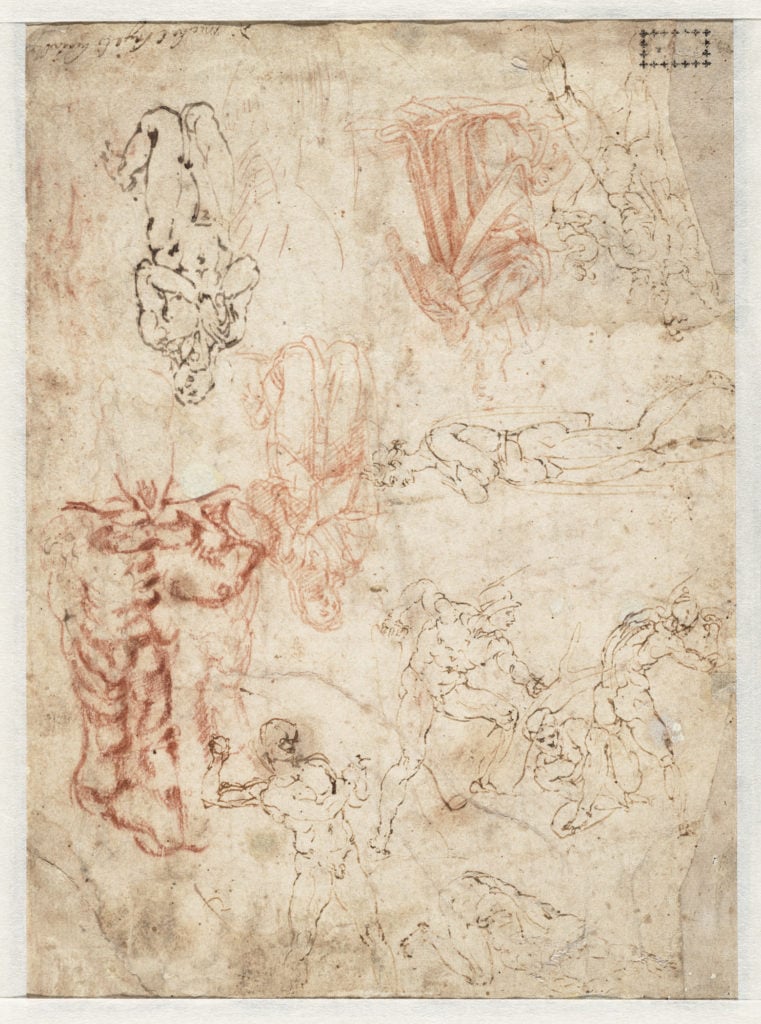
Michelangelo, Study of male torso; various figure studies (1518), verso. Courtesy of the Teylers Museum, Haarlem.
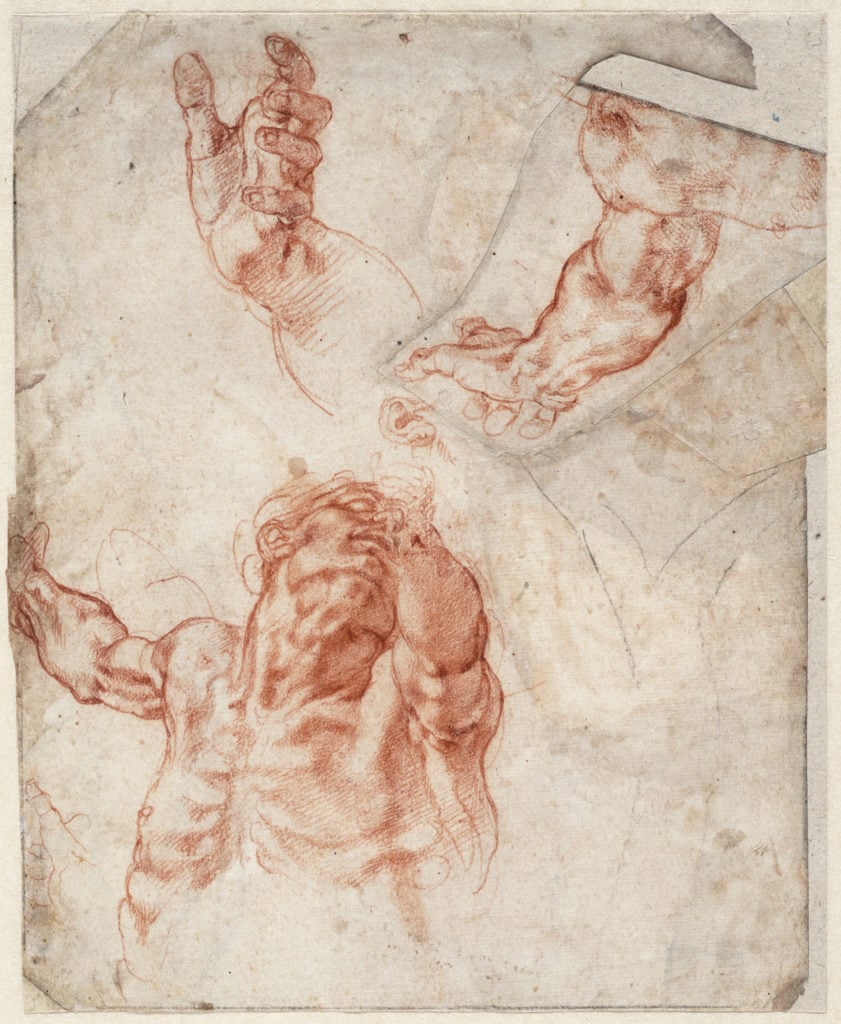
Michelangelo, Studies of the upper body of a man and separate studies of an arm, a hand, and an ear; sketch of a tree (1511–12), recto. Courtesy of the Teylers Museum, Haarlem.
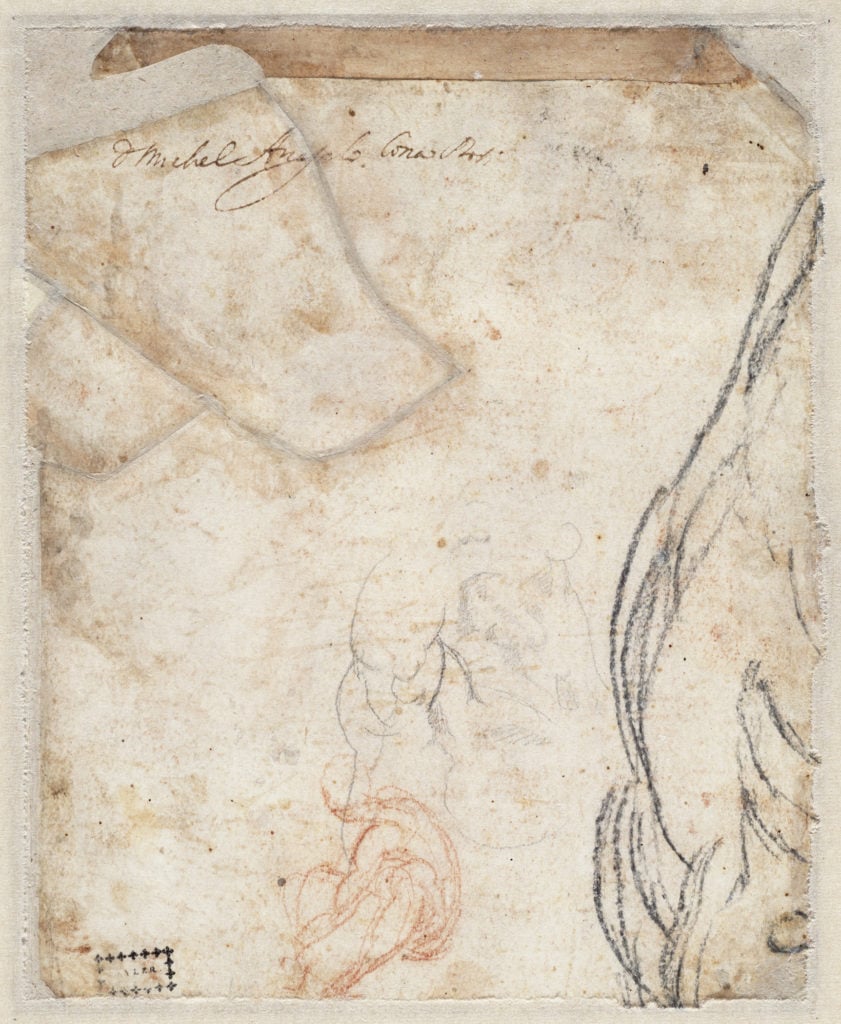
Michelangelo, Fragmentary cartoon of a male head; upper body of a man; study of a crouching figure (1511–12), verso. Courtesy of the Teylers Museum, Haarlem.
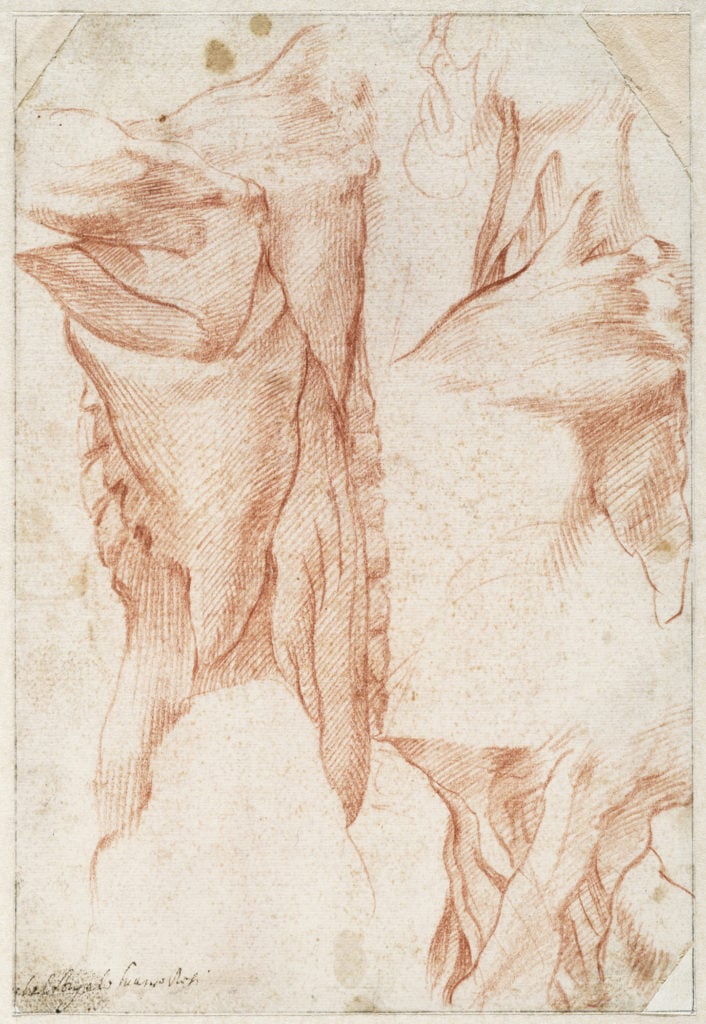
Michelangelo, Studies of a neck and shoulder, from the back and side (1515–20), verso. Courtesy of the Teylers Museum, Haarlem.
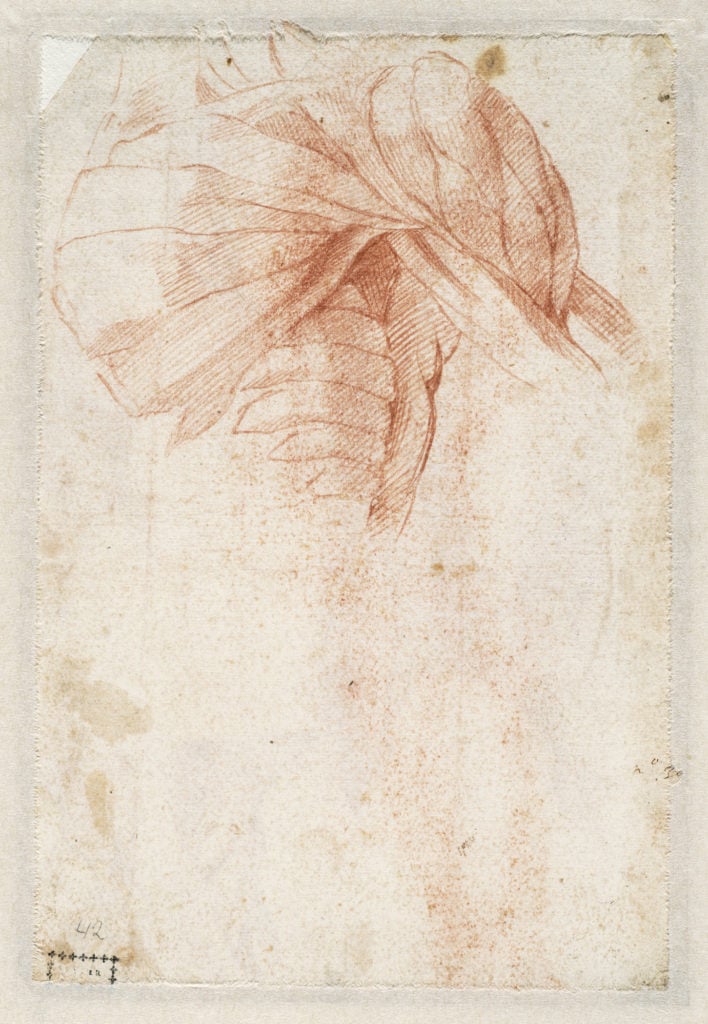
Michelangelo, Study of a shoulder (1515–20), verso. Courtesy of the Teylers Museum, Haarlem.
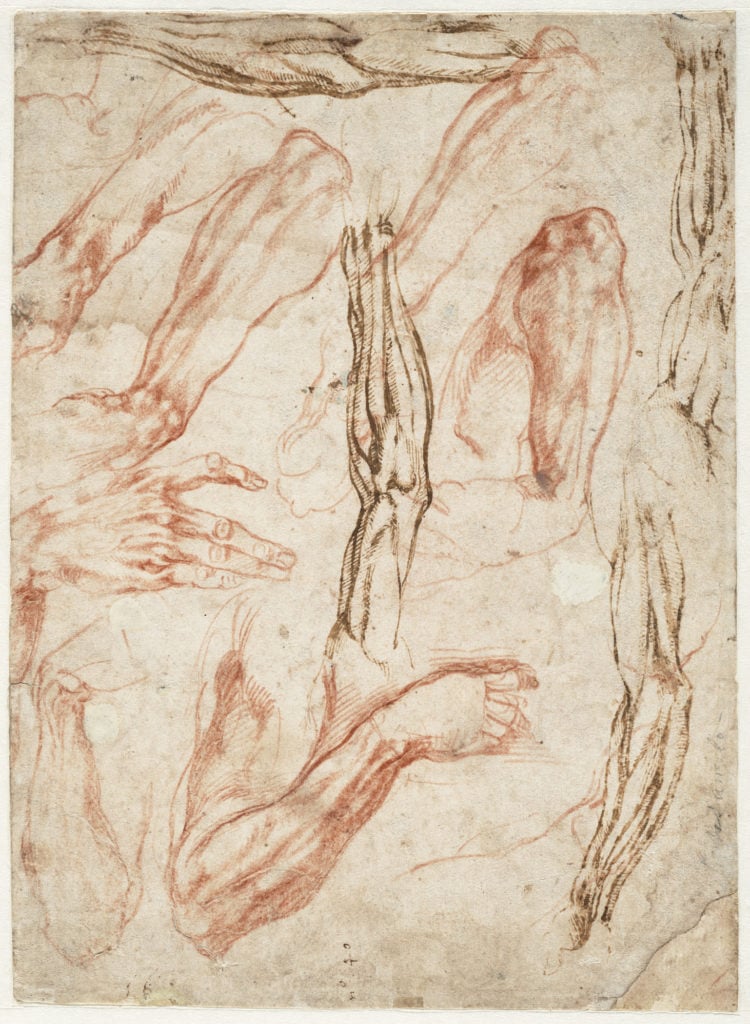
Michelangelo, Studies of arms and hands (1513–14), recto. Courtesy of the Teylers Museum, Haarlem.
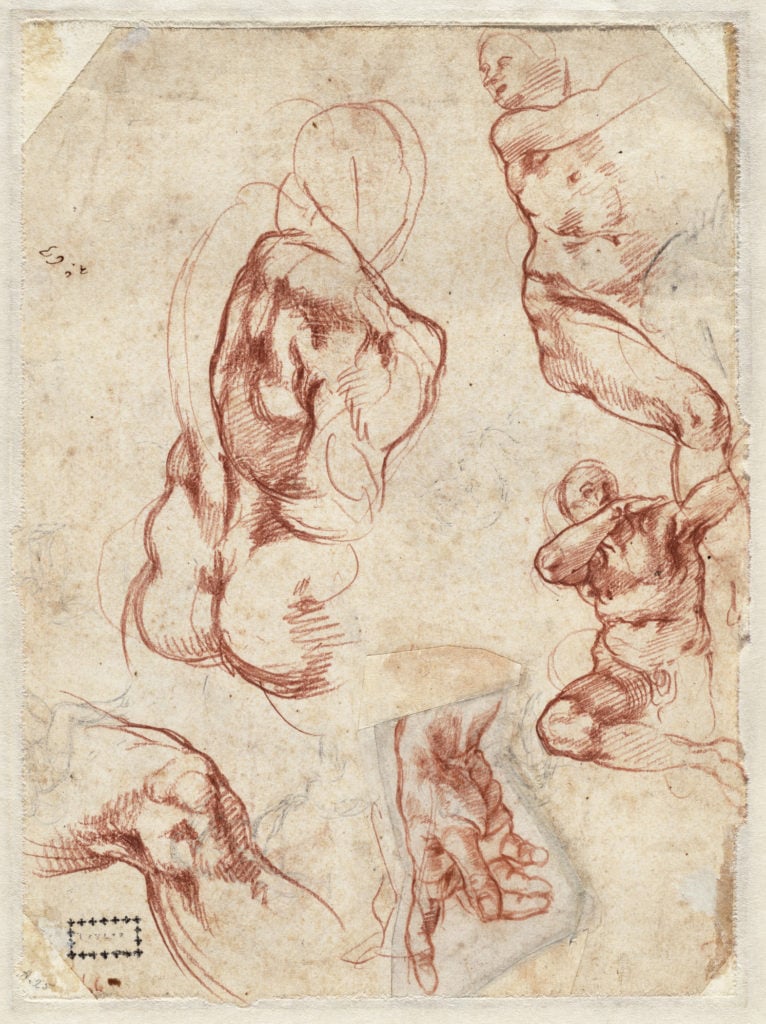
Michelangelo, Various figure studies (1511), verso. Courtesy of the Teylers Museum, Haarlem.
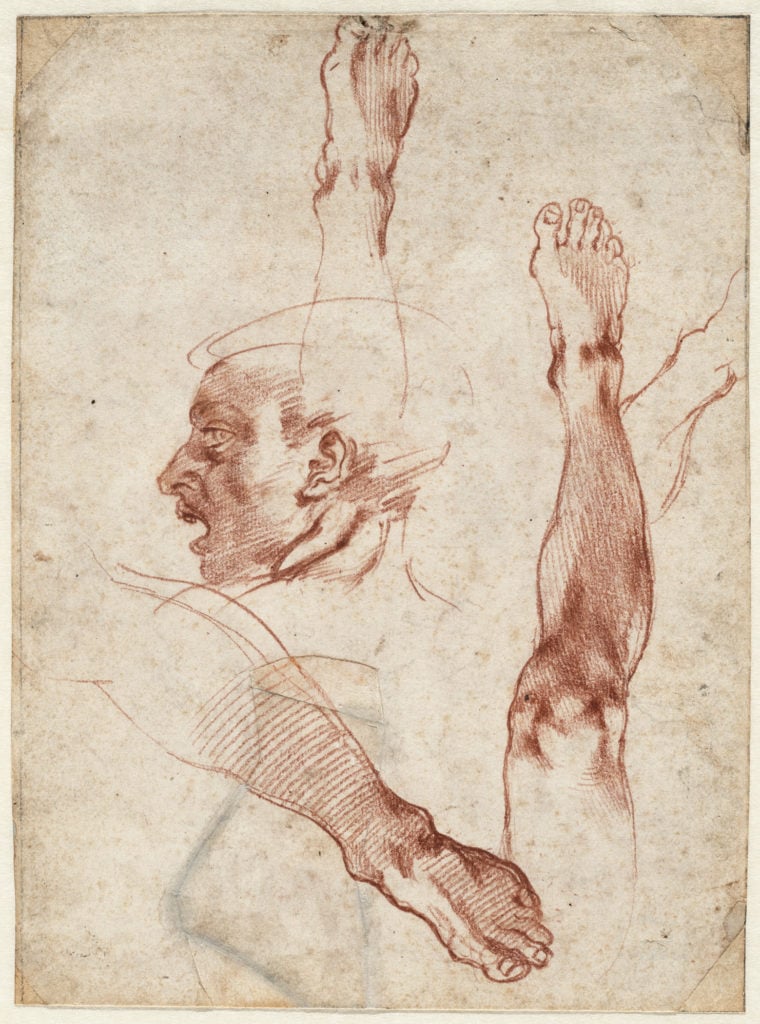
Michelangelo, Male head in profile, studies of limbs (1511), recto. Courtesy of the Teylers Museum, Haarlem.
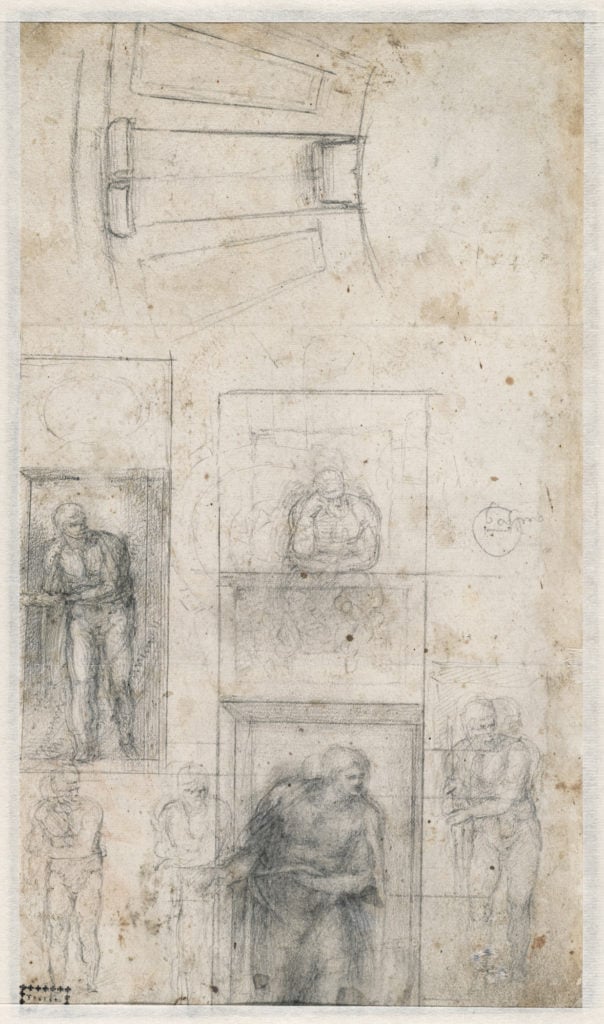
Michelangelo, Ground plan of the lantern’s base with volutes; figure studies (1547–59), verso. Courtesy of the Teylers Museum, Haarlem.
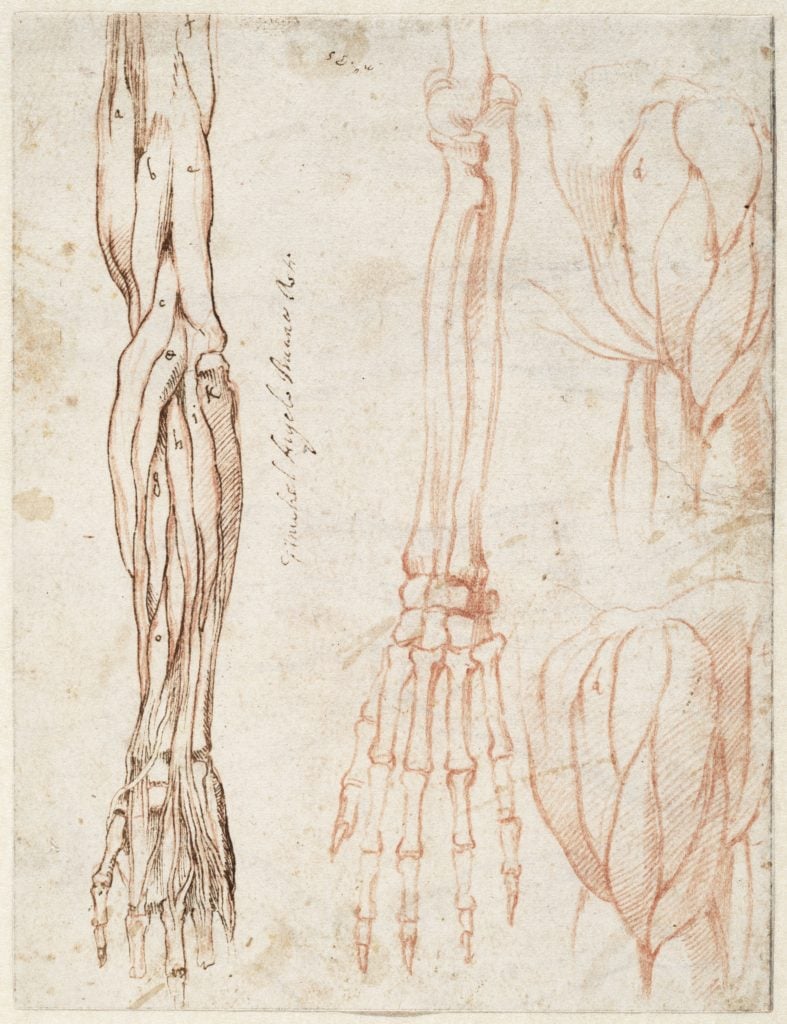
Michelangelo, Studies of a left arm and a shoulder (1515–20), recto. Courtesy of the Teylers Museum, Haarlem.
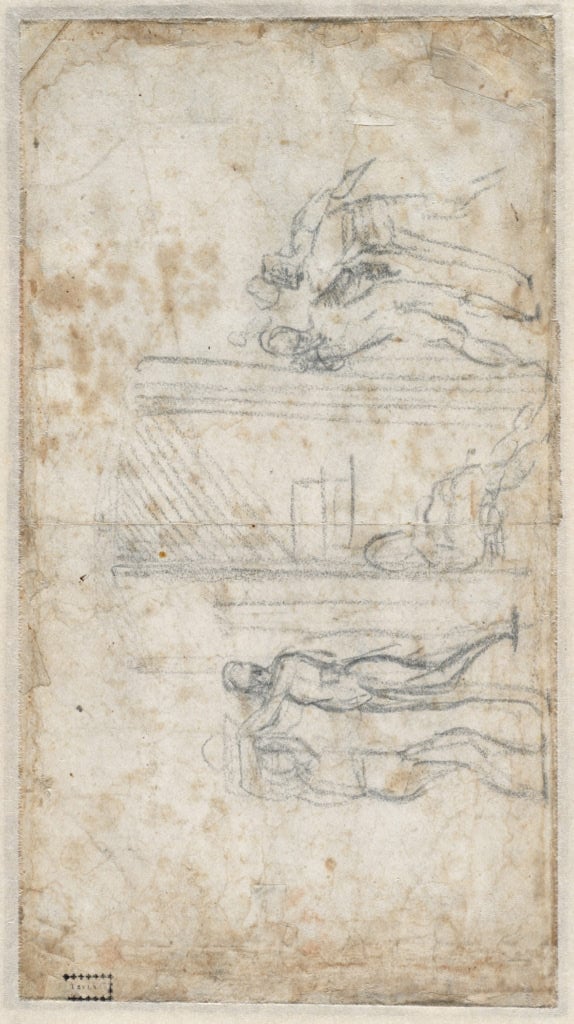
Michelangelo, Composition sketch with Judith and Holofernes (1506–08), verso. Courtesy of the Teylers Museum, Haarlem.
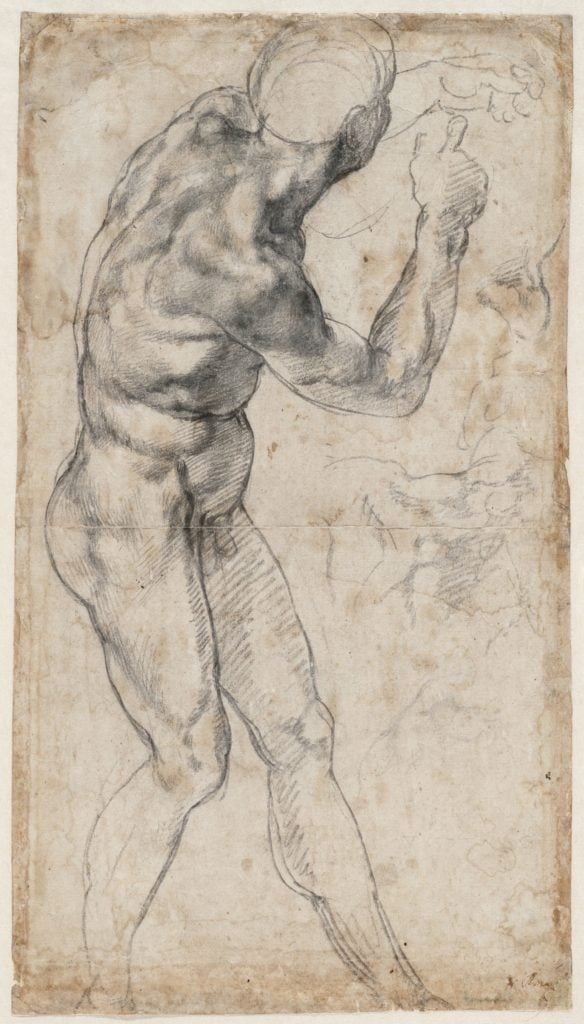
Michelangelo, Male nude, turning to the right; studies of anatomical details (1504–06), recto. Courtesy of the Teylers Museum, Haarlem.

Michelangelo, Figure studies for the Sistine ceiling (1510–11), verso. Courtesy of the Teylers Museum, Haarlem.
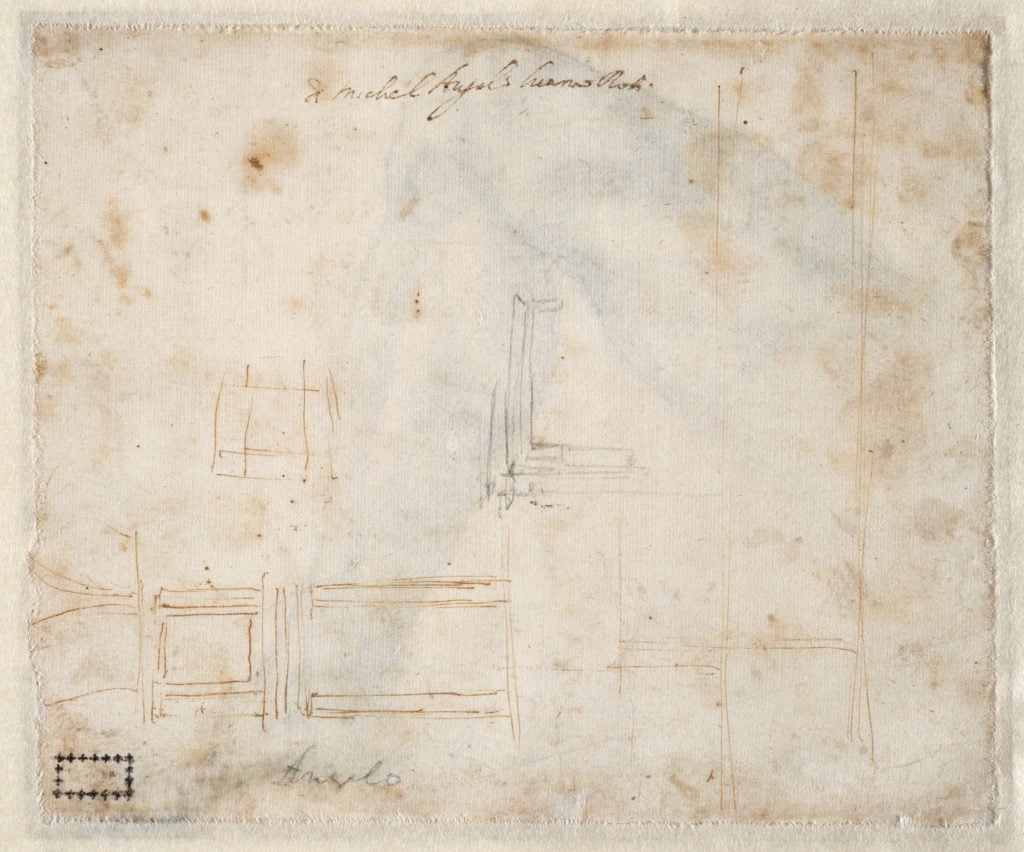
Michelangelo, Architectural studies (1524), verso. Courtesy of the Teylers Museum, Haarlem.
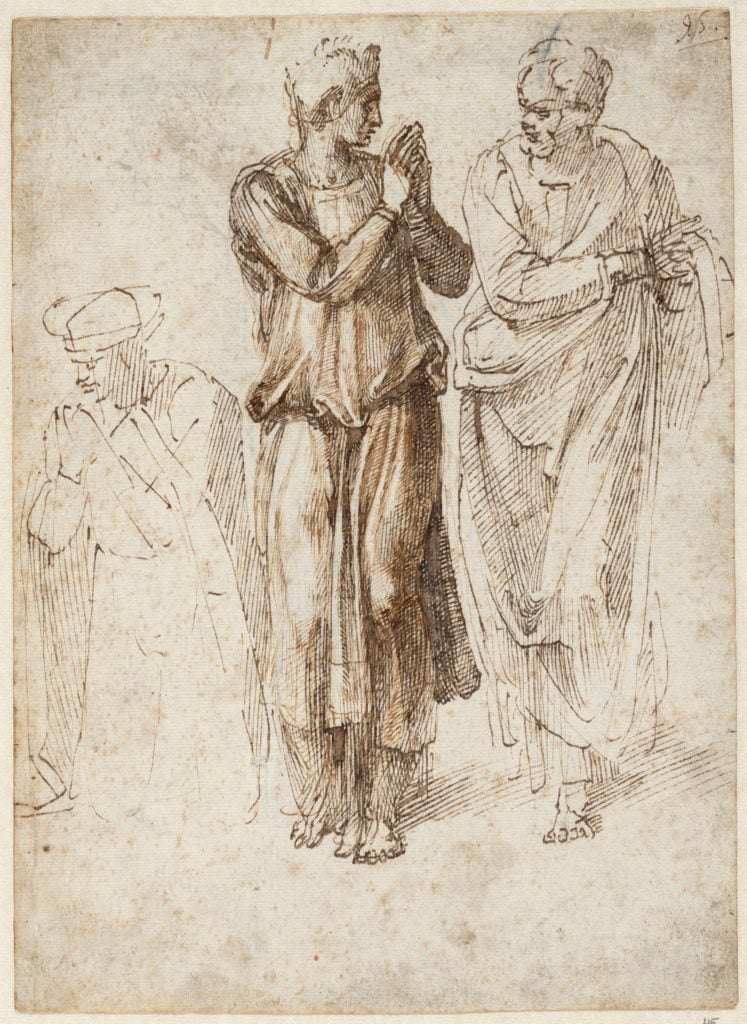
Michelangelo, Three draped figures, with hands joined, one kneeling, the others standing (1496–1503), recto. Courtesy of the Teylers Museum, Haarlem.

Michelangelo, Two robed figures bending forward, in profile to the right (1496–1503), verso. Courtesy of the Teylers Museum, Haarlem.
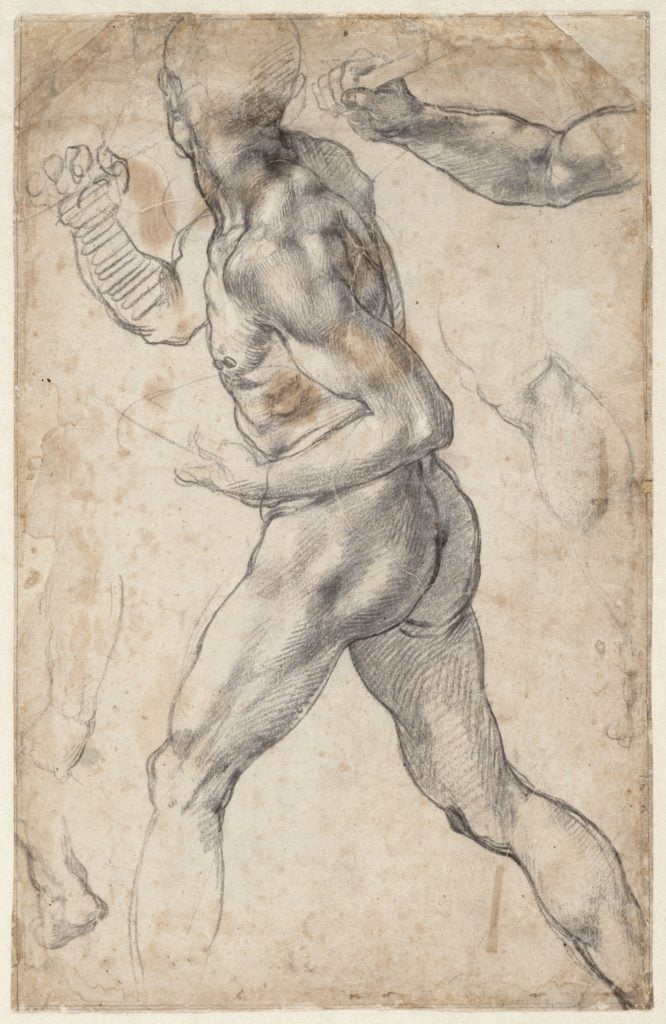
Michelangelo, Study of a striding male nude, to the left; studies of anatomical details (1504 of 1506), recto. Courtesy of the Teylers Museum, Haarlem.
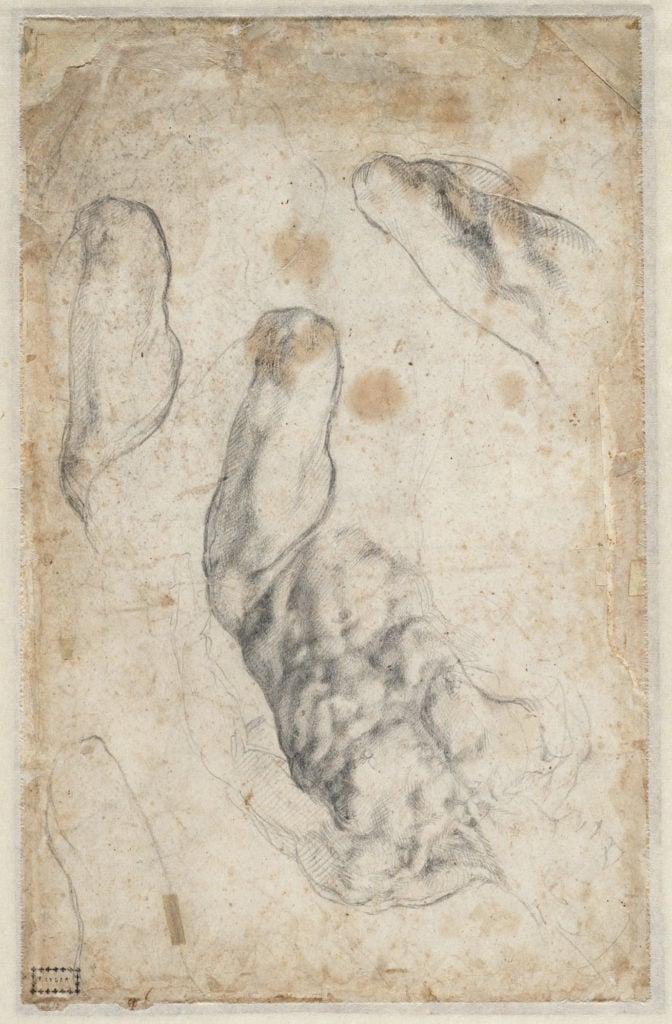
Michelangelo, Study of torso and left leg of a male nude; separate studies of the left leg (1525–30), verso. Courtesy of the Teylers Museum, Haarlem.
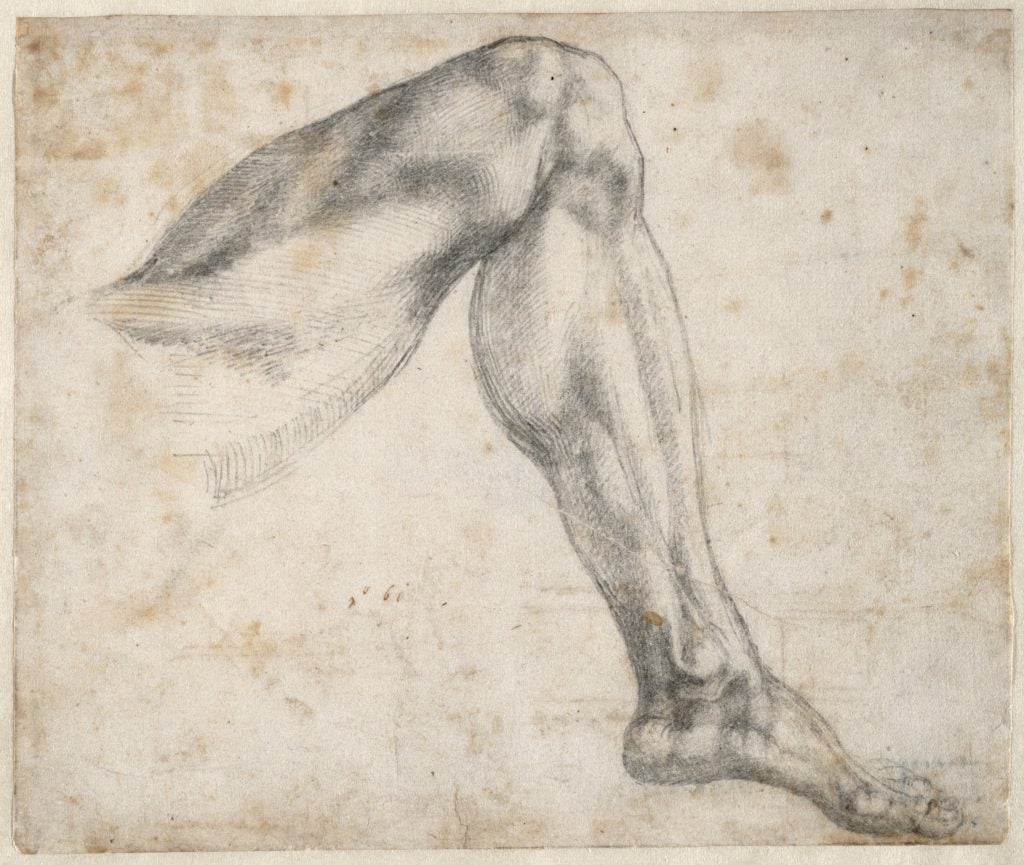
Michelangelo, Study of a leg (1524), recto. Courtesy of the Teylers Museum, Haarlem.
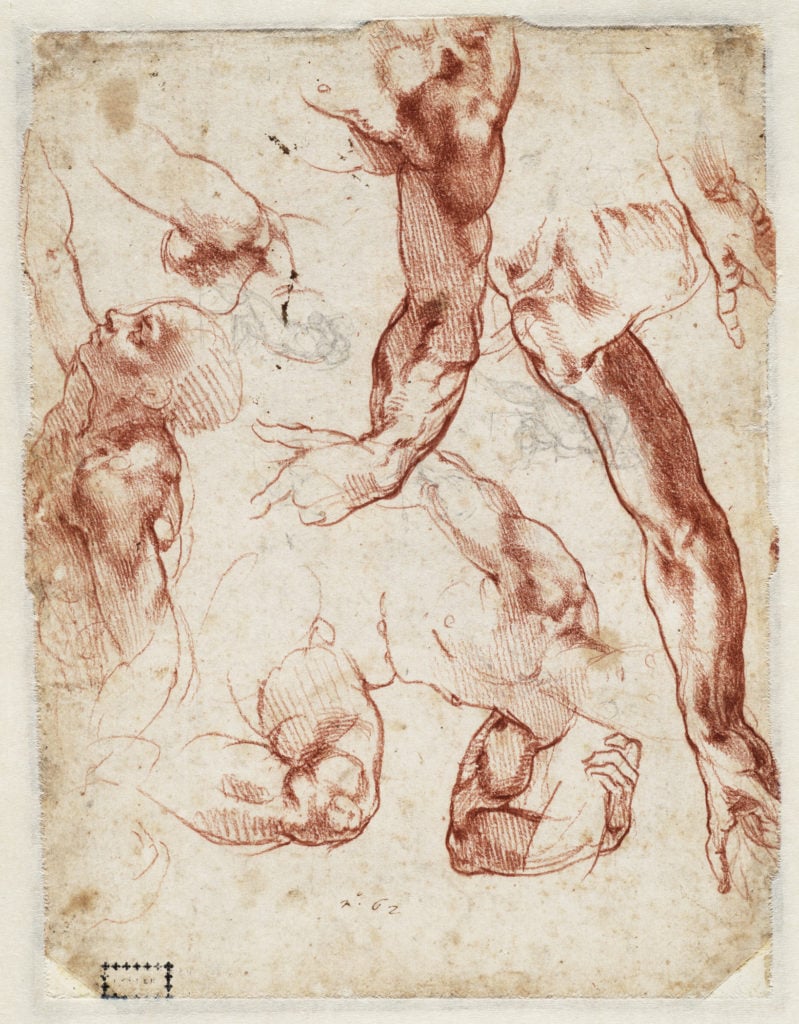
Michelangelo, Studies of figures and limbs; figure sketches (1511), verso. Courtesy of the Teylers Museum, Haarlem.
“Michelangelo: Mind of the Master” is on view at the Cleveland Museum of Art, 11150 East Boulevard, Cleveland, Ohio, September 22, 2019–January 5, 2020; and the J. Paul Getty Museum, 1200 Getty Center Drive, Los Angeles, California, February 25, 2019–June 7, 2020.
















































